Get in Touch With Attiroof
For top-tier, custom roofing solutions, trust Attiroof. Our commitment to quality and service is unmatched. Reach out to start your project today.
Feb. 29, 2024
The Comprehensive Guide to Gutter Systems for Roofing
As Attiroof, we understand the importance of every aspect of your roofing, and that's why we've created this comprehensive guide to gutter systems. Gutters are more than just functional elements; they are crucial in protecting your home from the elements and enhancing its overall appeal. In this guide, we'll walk you through the essentials of gutter systems – exploring various types, materials, and their impacts on both aesthetics and functionality. Our goal is to provide you, whether you're a homeowner or a professional, with the insights and knowledge needed to make the best choices for your roofing needs.
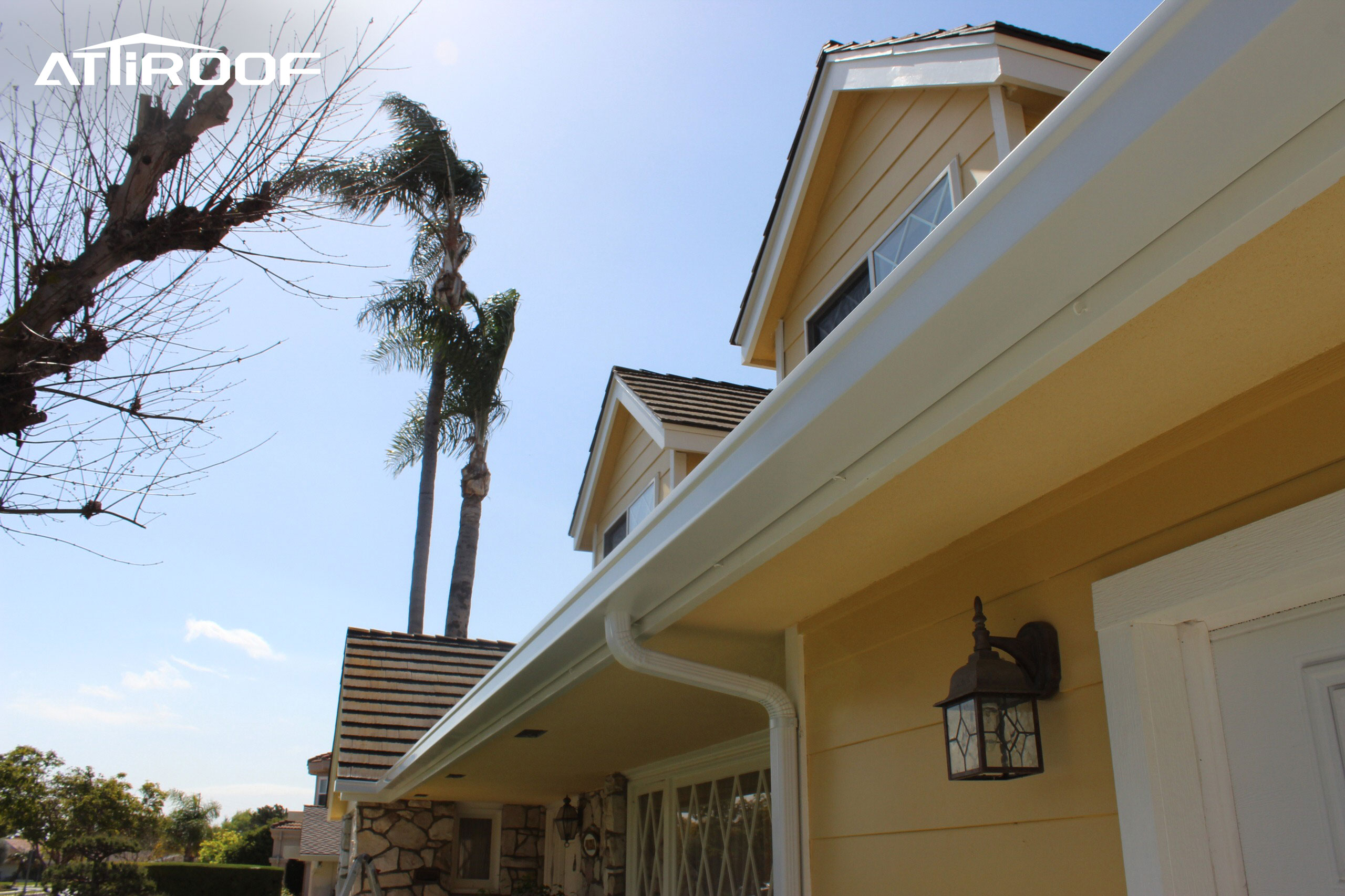
Gutter systems are the unsung heroes of roofing, playing a critical role in protecting your home from water damage. At Attiroof, we emphasize the importance of these systems in effectively channeling away rainwater, thus safeguarding your home's foundation, preventing soil erosion, and maintaining structural integrity.
Gutters are not just functional necessities; they also contribute to the aesthetic appeal of your home. Understanding their significance is crucial in maintaining the longevity and safety of your living space, a commitment we at Attiroof take seriously in helping you achieve.
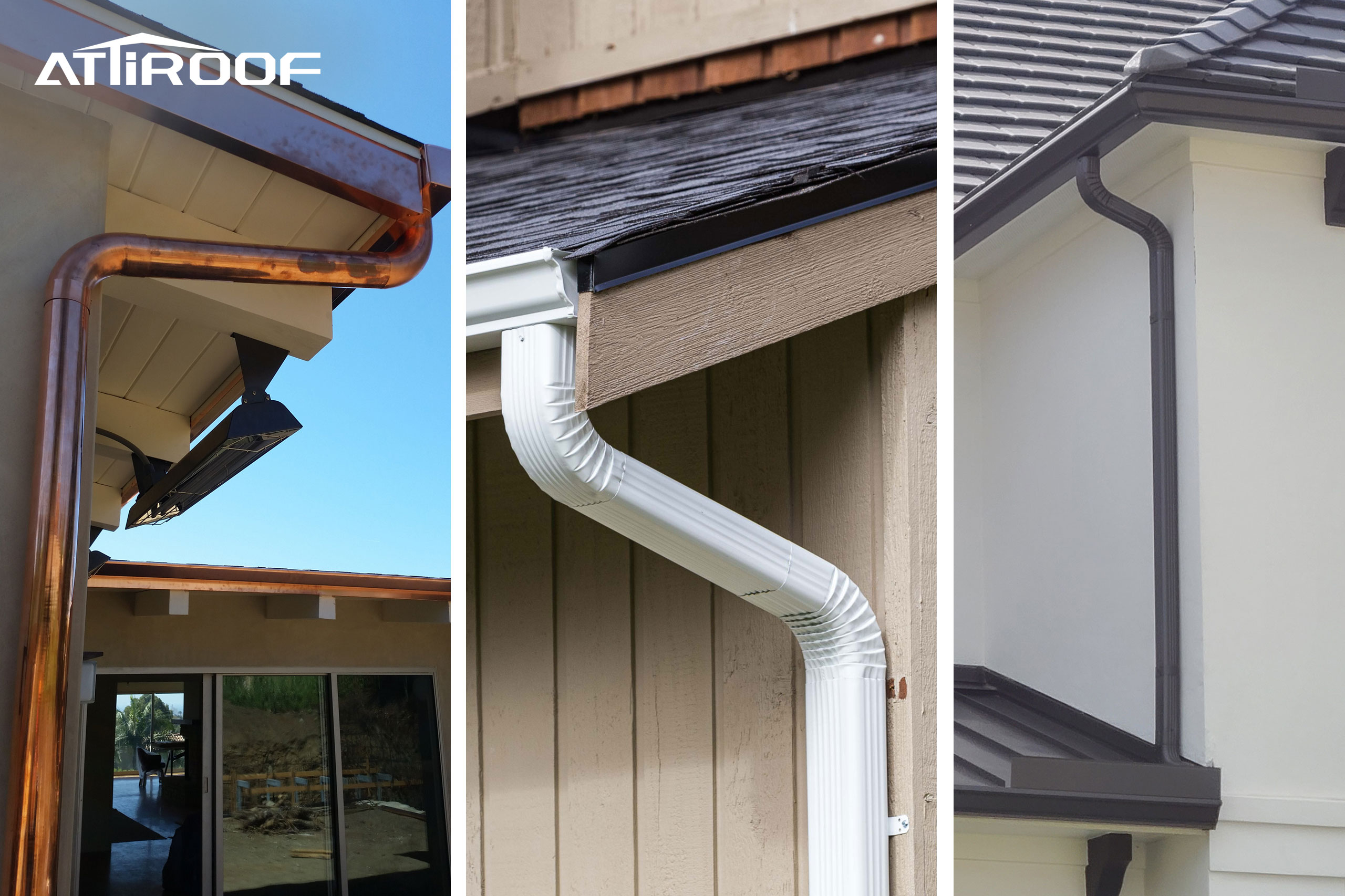
Gutter systems are an essential component of roofing, integral to maintaining the integrity and functionality of any building structure. These systems, designed to control the flow of rainwater, are crucial for protecting the roof and the building’s foundation from water damage.
Function and Composition:
A gutter system primarily consists of gutters and downspouts. Gutters, typically horizontal channels, are installed along the edges of the roof to collect rainwater. This water is then directed to downspouts, which carry it safely away from the building's foundation.
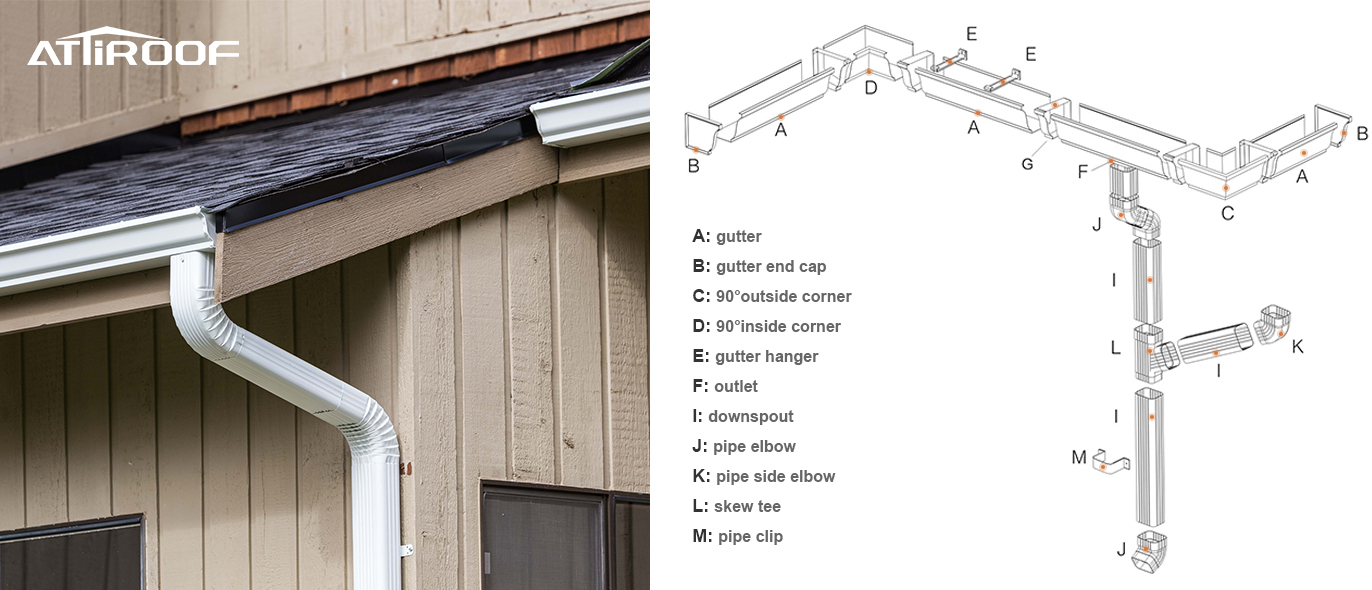
Materials and Varieties:
Various materials are used in gutter production, including aluminum, vinyl, steel, and copper, each offering unique benefits in durability, cost, and appearance. The choice of material often depends on the climate, architectural style, and specific roofing requirements.
Customization for Efficiency:
Customization of gutters is vital to ensure they work efficiently with the roof's design and local weather conditions. The size and style of the gutter system should be chosen based on the roof's dimensions and the average rainfall in the area.
Importance of Installation and Maintenance:
Correct installation and regular maintenance of gutter systems are key to their effectiveness. Properly installed and well-maintained gutters protect the roof and the building’s structure by ensuring optimal water flow, thereby preventing leaks and reducing the risk of water damage.
Understanding these basic aspects of gutter systems underlines their significance in preserving the longevity and aesthetic appeal of a building, making them more than just an accessory, but a vital part of roof architecture.
1. Protection Against Water Damage:
The primary role of gutters is to channel rainwater away from the building, preventing water accumulation that can cause basement flooding, soil erosion, and structural damage to the foundation.
2. Maintaining Roof Integrity:
Gutters are essential in preventing water from pooling on the roof, which can cause damage to roofing materials, lead to leaks, and create issues like mold and rot, particularly in vulnerable areas of the roof.
3. Soil and Landscape Preservation:
Effective water management through gutters also includes protecting the property's landscaping. Gutters help prevent soil erosion around the building, thereby maintaining the aesthetic and structural integrity of the landscape.
4. Enhancing Roof Longevity:
A well-functioning gutter system contributes to the longevity of the roof by ensuring that water is efficiently diverted away. This helps maintain the roof in good condition, reducing the need for frequent repairs and replacements.
In essence, gutters are indispensable for the effective management of rainwater, playing a pivotal role in protecting the roof and the entire building from water-induced damage. Their proper installation and maintenance are key to ensuring the longevity and functionality of roofing systems.
When it comes to protecting your home from the elements, the choice of the right gutter system is as crucial as the choice of roofing material. Here at Attiroof, we understand that the variety in gutter systems can be overwhelming, which is why we've put together this section to guide you through the different types available and how to select the one that best suits your needs. From seamless to sectional, and from vinyl to copper, each type of gutter has unique features and benefits. We'll delve into the specifics of each, helping you make an informed decision that complements your roofing and provides optimal protection for your home.
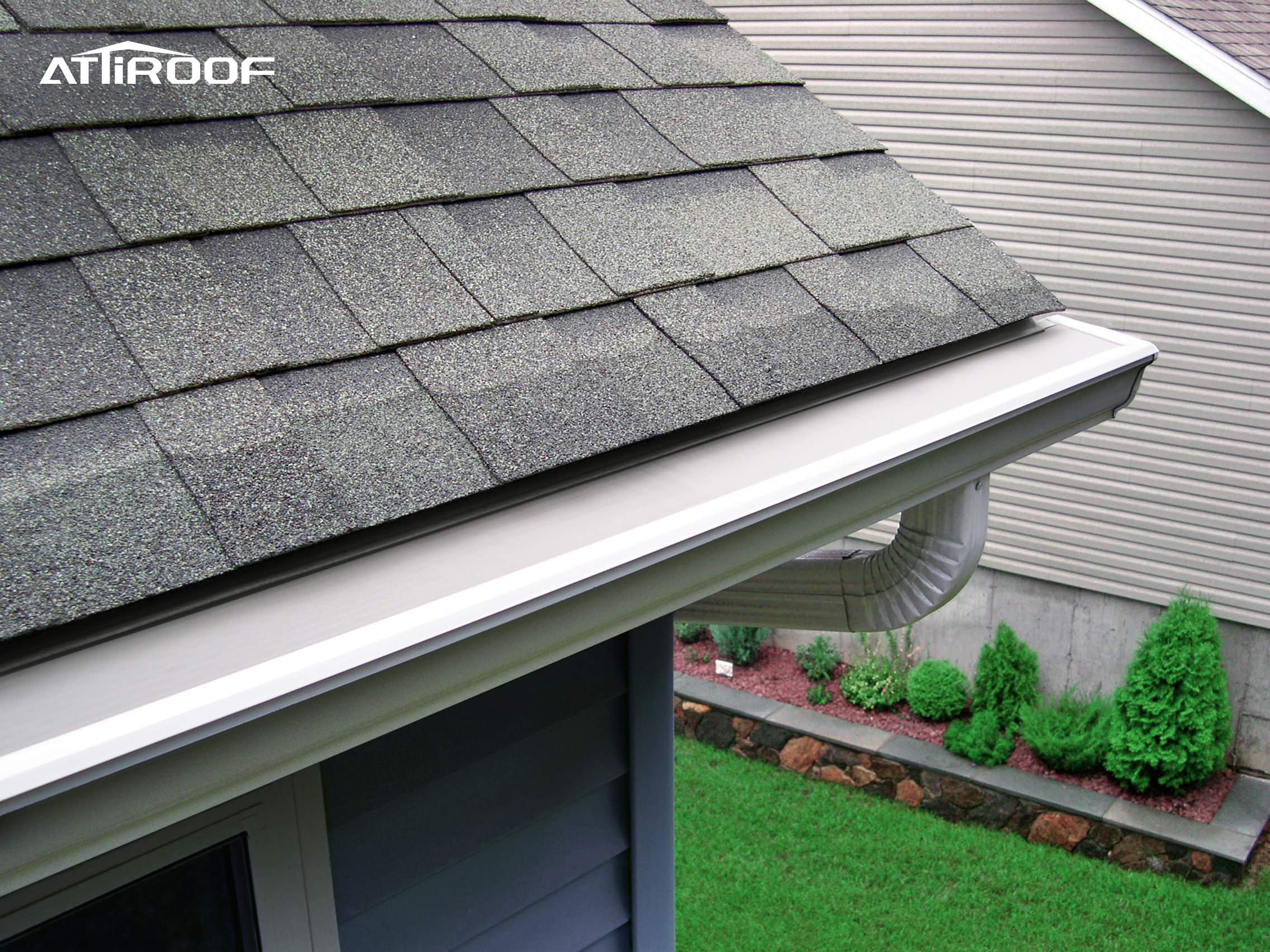
Seamless gutters are a popular choice among homeowners for their efficiency and aesthetic appeal. Unlike sectional gutters, which are composed of multiple pieces joined together, seamless gutters are made from a single piece of material, typically cut to length on-site using a special machine.
Advantages of Seamless Gutters:
1. Reduced Leaks: Since seamless gutters have no joints except at the corners and downspouts, they are less prone to leaks. This makes them highly efficient in channeling water away from your home.
2. Custom Fit: Being custom-made to fit each home, seamless gutters offer a snug, precise fit that enhances their performance and longevity.
3. Maintenance: With fewer joints, seamless gutters are less likely to accumulate debris and are therefore easier to clean and maintain.
4. Aesthetic Appeal: Seamless gutters provide a smooth, uniform look to the edges of your roof, which many homeowners find visually appealing.
5.Material Choices: They are available in various materials like aluminum, which is lightweight and resistant to corrosion, and copper, known for its durability and unique appearance.
When considering seamless gutters for your home, particularly in combination with Attiroof’s roofing solutions, it's important to weigh these advantages against factors like cost and installation requirements. While they may have a higher upfront cost than sectional gutters, their durability and lower maintenance needs can make them a cost-effective choice in the long run.
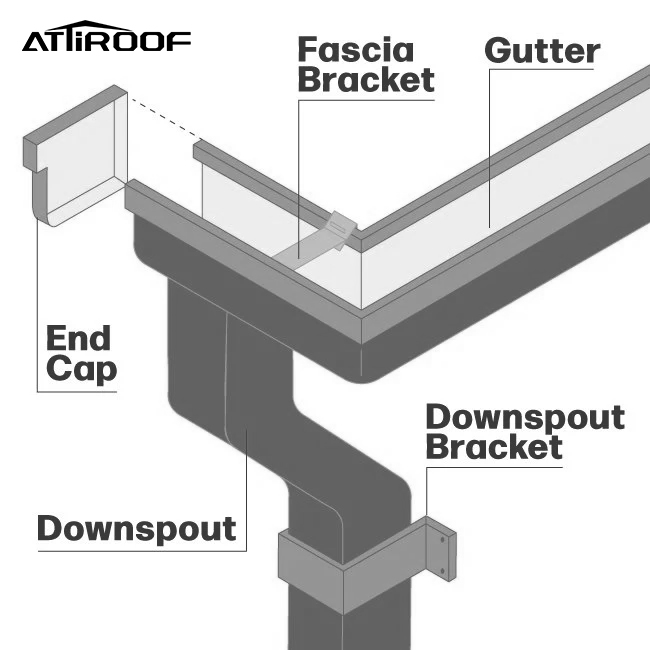
What are Sectional Gutters?
Sectional gutters are composed of smaller sections of guttering, usually in lengths of 10 to 20 feet, which are joined together during installation. This design allows for a customizable approach to fit the specific dimensions of a building's roofline.
Advantages of Sectional Gutters:
1. Cost-Effectiveness: One of the main benefits of sectional gutters is their affordability. The segmented nature of these gutters makes them more cost-effective than some other types, particularly when it comes to initial installation costs.
2. Ease of Installation: Sectional gutters are generally easier to install. Their modular design allows for adjustments and modifications on-site, making them a popular choice for DIY enthusiasts or for situations where a quick installation is needed.
3. Availability and Variety: These gutters are widely available in a range of materials, including vinyl, aluminum, and steel. Each material offers different benefits in terms of weight, durability, and resistance to weather conditions.
Considerations for Sectional Gutters:
1. Seams and Leaks: The main drawback of sectional gutters is the presence of seams, which can become potential points for leaks. Regular maintenance and inspection are crucial to ensure that the seals between sections remain intact.
2. Aesthetics: While sectional gutters offer functional benefits, they may lack the seamless appearance of other gutter types. However, with a range of materials and colors available, they can still be a visually appealing option for many homes.
When choosing sectional gutters, especially for homes with Attiroof's roofing materials, it's important to consider factors like the local climate, the architectural style of your home, and the long-term maintenance commitment. While they offer an affordable and flexible solution, the need for regular maintenance and the potential for leaks are important factors to weigh in your decision-making process.
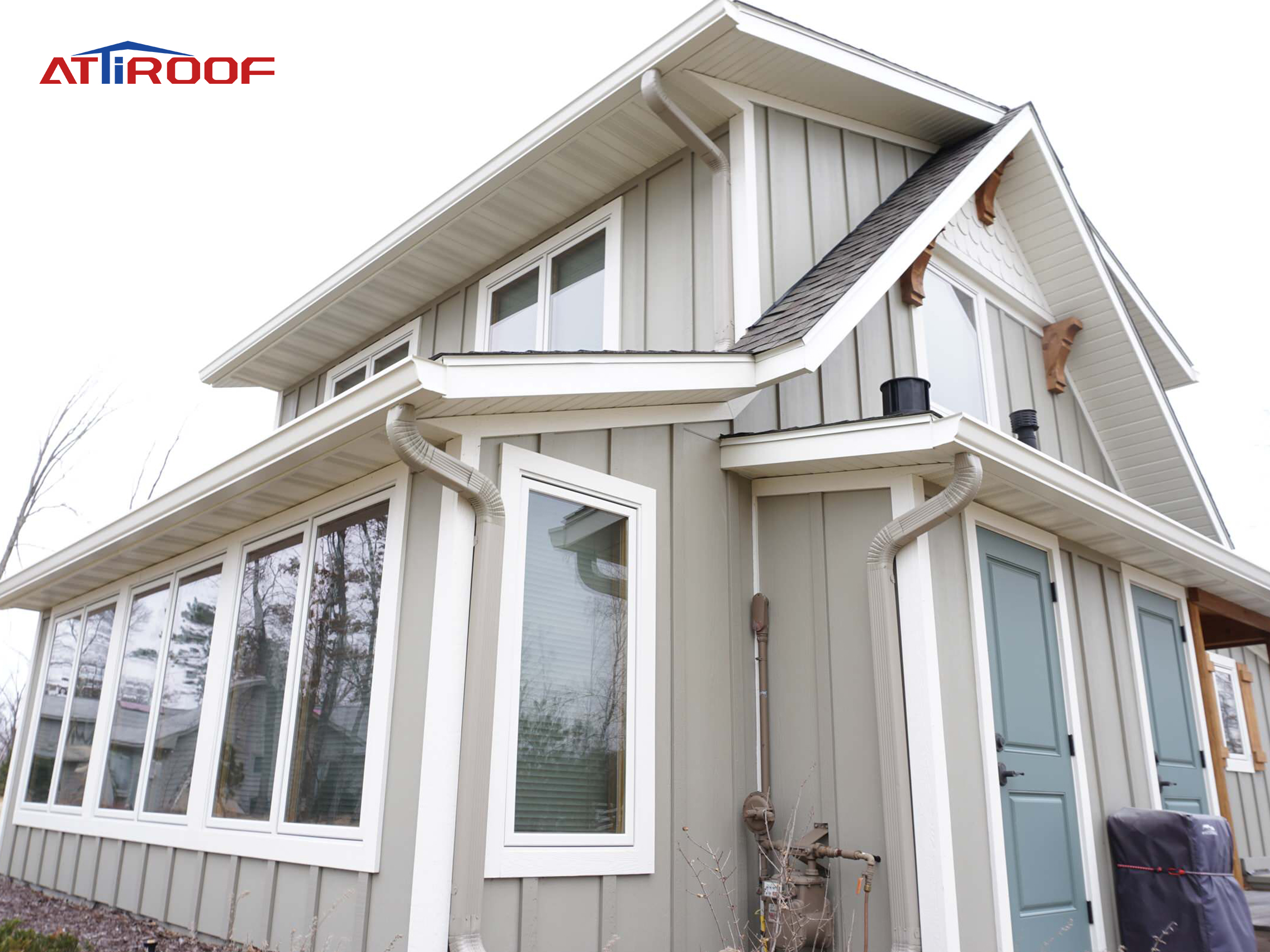
As an integral part of the roofing landscape, K-style gutters are a popular choice among homeowners, and at Attiroof, we understand their appeal and functionality. K-style gutters, named for their profile's resemblance to the letter 'K' when viewed from the side, offer both aesthetic and practical benefits.
Characteristics of K-Style Gutters:
1. Design and Appearance: The distinctive shape of K-style gutters, with a flat bottom and back, and a decorative front side that often mimics crown molding, complements the architectural style of many modern homes. This decorative aspect makes them a preferred choice for those looking to add a touch of elegance to their home's exterior.
2. Efficiency in Water Management: The design of K-style gutters isn't just for show; it also enhances their functionality. The shape allows for more water to be channeled and drained compared to half-round gutters of the same width, making them highly efficient, especially in areas with heavy rainfall.
3. Durability and Stability: Thanks to their flat bottoms and backs, K-style gutters are easier to attach to the fascia board, adding to their stability and durability. This design feature makes them less prone to bending or protruding when impacted by ladders or fallen branches.
Material Options for K-Style Gutters:
K-style gutters come in various materials, including aluminum, which is lightweight and rust-resistant, making it a popular choice. For those looking for more durability and a distinct look, copper and steel options are also available. Each material has its pros and cons in terms of longevity, maintenance, and cost.
Installation Considerations:
●While K-style gutters can be more challenging to install than half-round gutters due to their unique shape, they can be found in both seamless and sectional forms, offering flexibility in installation.
●The choice between seamless and sectional will depend on specific needs, such as the length of the gutter runs and the budget.
In conclusion, K-style gutters are an excellent choice for homeowners seeking a blend of aesthetic appeal and functional efficiency. Their design makes them a versatile option, suitable for a variety of homes, including those outfitted with Attiroof’s roofing solutions.When selecting K-style gutters, consider the material and installation type that best align with your home’s architectural style and your specific weather management needs.
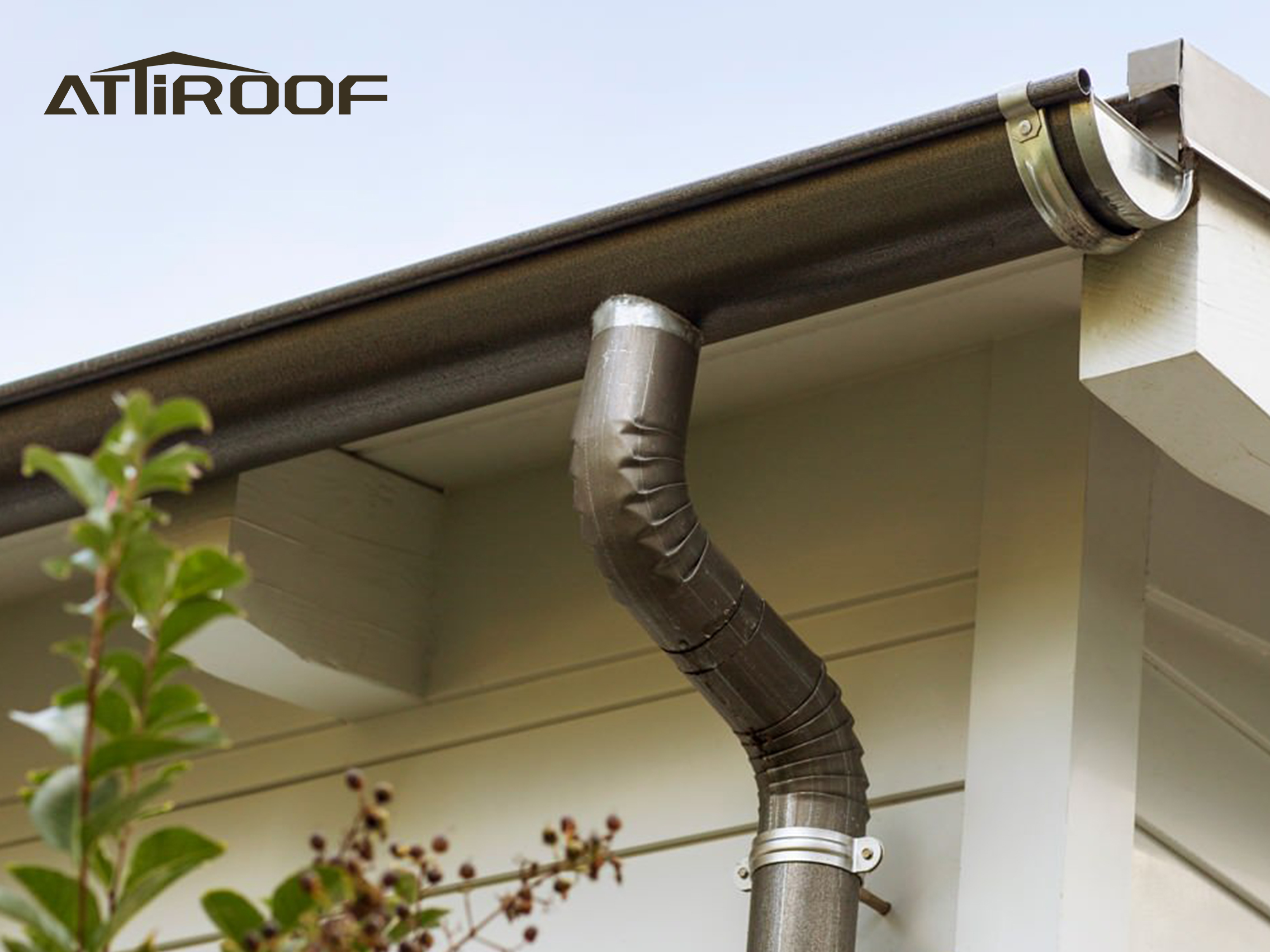
Distinctive Features of Half-Round Gutters:
●Classic Design: Half-round gutters, as the name suggests, are shaped like a half-circle, providing a smooth, curved profile. This classic design is particularly complementary to older, historic homes or properties where a traditional appearance is desired.
●Efficient Water Flow: The smooth, rounded shape of these gutters allows for easier and more efficient water flow compared to more angular styles. This design reduces the likelihood of water pooling and debris accumulation, leading to fewer clogs and easier maintenance.
Material Varieties in Half-Round Gutters:
●Material Options: Half-round gutters are available in various materials, including copper, aluminum, and galvanized steel. Copper half-round gutters offer a distinguished look and exceptional durability, aging gracefully over time to develop a unique patina.
●Aluminum and Steel Choices: Aluminum options provide lightweight durability and rust resistance, while galvanized steel is known for its strength and resistance to damage.
Installation and Maintenance Considerations:
●Installation Process: While the installation of half-round gutters can be more complex due to their shape and the need for specialized brackets, the end result is often worth the effort for the right property. They are typically installed using hidden hangers or exposed brackets, depending on the desired aesthetic.
●Maintenance Requirements: The curved design of half-round gutters makes them less prone to corrosion and buildup, but regular cleaning and inspection are still essential to maintain their efficiency and longevity.
Half-round gutters offer an elegant solution for homeowners looking to blend traditional style with effective roof water management. Their compatibility with a variety of roofing materials, including those offered by Attiroof, makes them a versatile option for many homes. When selecting half-round gutters, consider factors like architectural style, material preferences, and maintenance commitment to ensure they align with your overall roofing system needs.
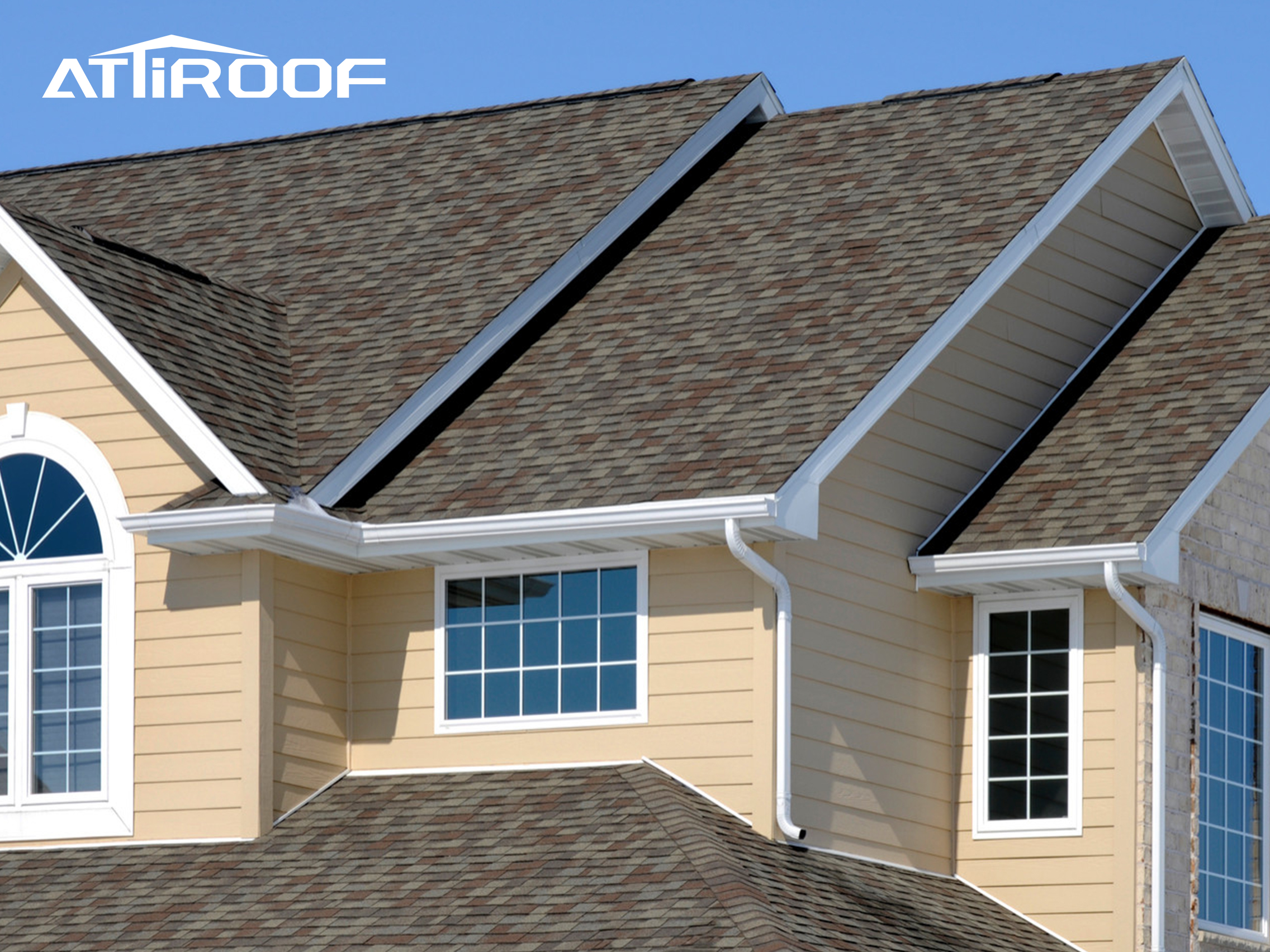
In the diverse world of gutter systems, vinyl gutters have emerged as a popular choice for many homeowners, including those opting for roofing solutions from Attiroof. Recognized for their ease of installation and maintenance, vinyl gutters offer several benefits and considerations worth exploring.
Characteristics of Vinyl Gutters:
●Lightweight and Durable: One of the primary advantages of vinyl gutters is their lightweight yet durable nature. Made from a type of plastic known as PVC (polyvinyl chloride), these gutters are designed to resist denting and cracking.
●Corrosion and Rust Resistance: Unlike metal gutter options, vinyl gutters are inherently resistant to corrosion and rust, making them ideal for homes in various climates, especially those with high moisture levels.
●Ease of Installation: Thanks to their lightweight material and snap-together parts, vinyl gutters are particularly user-friendly when it comes to installation. This ease of installation makes them a popular choice for DIY projects.
Aesthetic Appeal and Color Options:
●Variety of Colors: Vinyl gutters come in a wide range of colors, which can be an attractive feature for homeowners looking to match or complement their home’s exterior color scheme.
●Seamless Appearance: They often come in seamless styles, providing a clean, continuous look along the roofline.
Maintenance and Longevity:
●Low Maintenance Requirements: Vinyl gutters require minimal maintenance, mainly involving regular cleaning to prevent blockages. They do not need painting or finishing.
●Longevity Considerations: While vinyl gutters are durable, they may not have the same lifespan as some metal alternatives, particularly in extreme weather conditions. UV exposure over time can also lead to the material becoming brittle.
Cost-Effectiveness:
●Affordability: One of the most appealing aspects of vinyl gutters is their cost-effectiveness. They are generally more affordable than metal gutter systems, making them an excellent choice for homeowners on a budget.
In summary, vinyl gutters are a practical and aesthetically versatile option, suitable for many homes and compatible with various roofing styles, including those offered by Attiroof. When considering vinyl gutters, it's important to weigh their ease of installation and maintenance against factors like longevity and climate suitability to ensure they align with your specific roofing needs and preferences.

Aluminum gutters are a highly popular choice in the realm of gutter systems, and at Attiroof, we recognize their significant advantages for a wide range of roofing needs. Aluminum gutters offer a combination of durability, affordability, and versatility, making them an excellent choice for many homeowners.
Key Features of Aluminum Gutters:
●Durability: One of the most notable features of aluminum gutters is their durability. They are resistant to rust and corrosion, which makes them an ideal choice in various climates, including those with high rainfall or humidity.
●Lightweight: Aluminum is a lightweight material, which makes these gutters easier to handle and install. This property also puts less strain on the roofing and fascia to which they are attached.
●Customization and Variety: Aluminum gutters come in a variety of colors and can be painted, offering homeowners the flexibility to match their gutter system with their home's exterior. They are available in various styles, including K-style and half-round, and can be custom-fitted as seamless gutters.
Advantages of Aluminum Gutters:
●Cost-Effectiveness: Compared to other materials like copper or steel, aluminum gutters are more cost-effective, offering a balance between quality and affordability.
●Low Maintenance: These gutters require minimal maintenance. They do not rust, and their color holds up well over time, which means less frequent painting or finishing.
●Longevity: With proper installation and occasional maintenance, aluminum gutters can last for many years, making them a long-term investment for your home.
Considerations for Choosing Aluminum Gutters:
●Suitability for Various Roof Types: Aluminum gutters are compatible with a wide range of roofing materials and styles, including the various offerings from Attiroof.
●Climate Compatibility: While they are resistant to rust and corrosion, it is important to consider the local climate, as extreme weather conditions may impact their longevity.
●Installation and Professional Assistance: Although aluminum gutters can be a DIY project due to their lightweight nature, professional installation is recommended to ensure they are properly fitted and secured, especially for seamless options.
In conclusion, aluminum gutters are an excellent all-around choice for most homes. They provide a practical, durable, and aesthetically pleasing solution for effective water management in roofing systems. When paired with Attiroof’s roofing products, they contribute to a comprehensive and cohesive roofing solution, enhancing both the functionality and the curb appeal of your home.
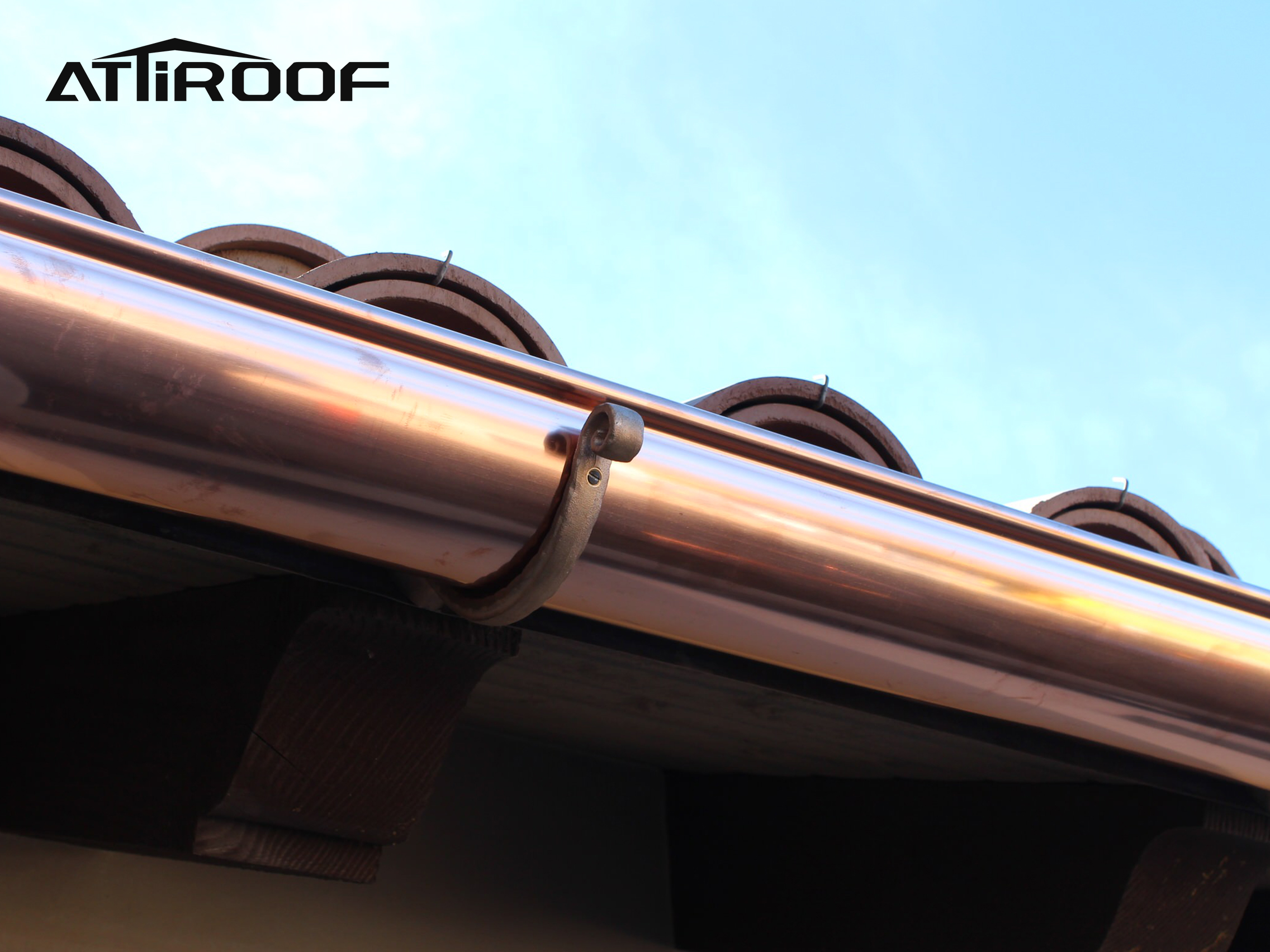
Copper gutters are a premium choice in the gutter system market and, at Attiroof, we appreciate their unique blend of aesthetic appeal and long-lasting durability. Ideal for homeowners looking for a blend of elegance and performance, copper gutters offer distinctive advantages that set them apart in the roofing industry.
Unique Characteristics of Copper Gutters:
●Aesthetic Appeal: Copper gutters are renowned for their striking visual appeal. Over time, they develop a patina, transitioning from their original shiny metallic hue to a distinctive greenish-blue color. This natural aging process adds a touch of historic elegance and charm to any property.
●Durability and Strength: Copper is extremely durable, making it an excellent material for gutters. It withstands harsh weather conditions, is resistant to corrosion, and does not rust. This resilience translates to a longer lifespan, often outlasting the roofing materials to which they are attached.
●Low Maintenance: Copper gutters require minimal maintenance. Their resistance to rust and corrosion means they need less frequent cleaning and repair, making them a convenient option for many homeowners.
Advantages of Copper Gutters:
●Increased Home Value: Installing copper gutters can increase the value of a property due to their longevity and timeless look. They are often sought after in high-end home constructions and renovations.
●Eco-Friendly Material: Copper is a sustainable choice; it is 100% recyclable, making it an environmentally friendly option for gutter systems.
●Versatility in Design: Copper gutters fit well with a variety of architectural styles, from traditional to contemporary, enhancing the overall aesthetic of a building.
Considerations for Copper Gutters:
●Initial Investment: While copper gutters offer numerous benefits, they are more expensive upfront compared to materials like aluminum or vinyl. However, their longevity and low maintenance needs can make them cost-effective over time.
●Professional Installation Required: To ensure maximum performance and aesthetic appeal, professional installation of copper gutters is recommended. Proper installation is crucial to prevent potential issues like seam leaks or improper drainage.
In summary, copper gutters are an excellent investment for those seeking a combination of beauty, durability, and eco-friendliness. Their elegant appearance and robust performance make them a superb choice for homeowners who want to pair their Attiroof roofing solutions with a gutter system that stands out both in functionality and style. While the initial cost may be higher, the long-term benefits and distinctive appearance make copper gutters a worthwhile addition to any home.
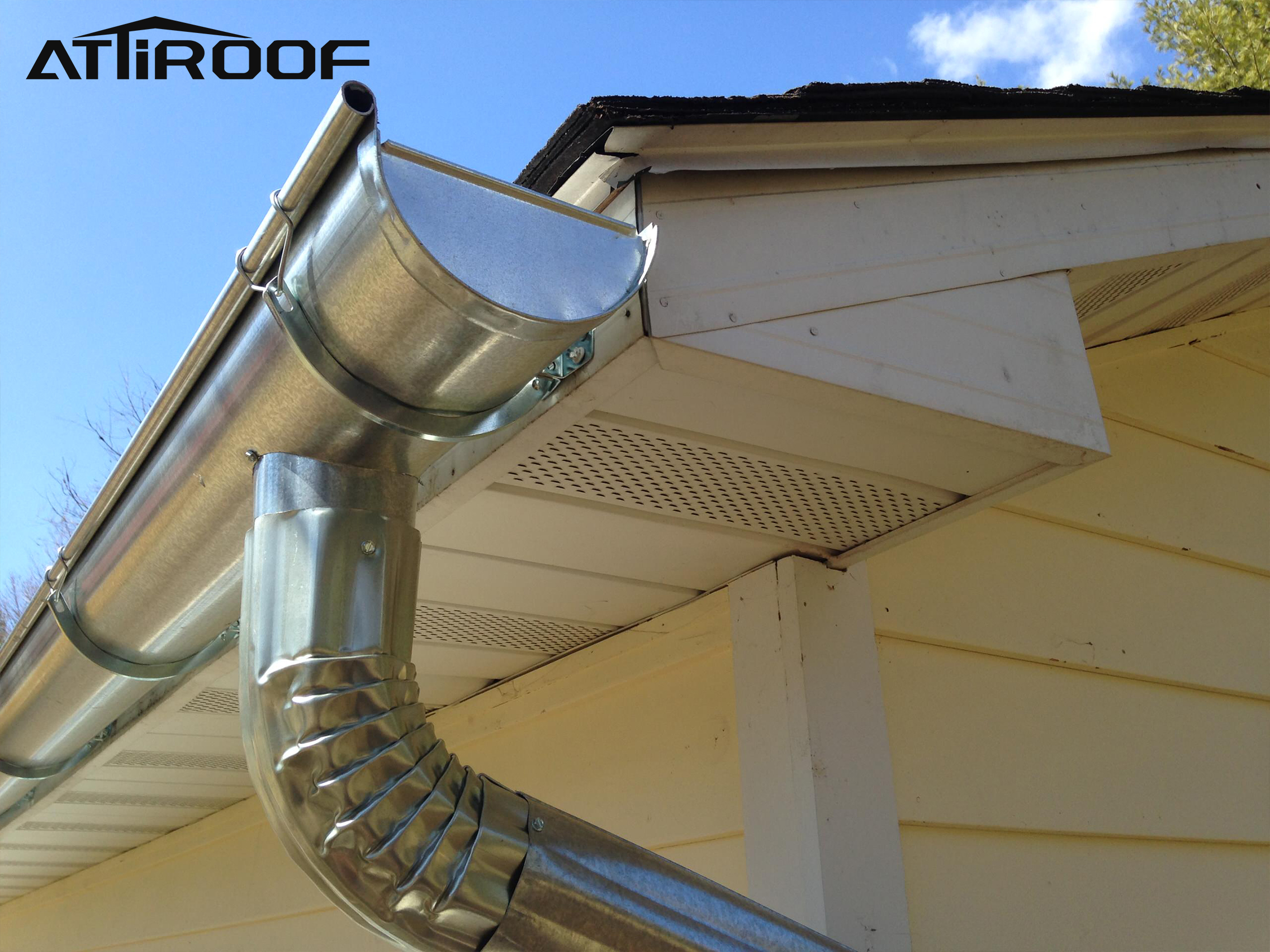
Steel gutters stand as a testament to durability and structural integrity in the realm of roofing solutions. Recognizing the essential role a robust gutter system plays in safeguarding a home's structure, Attiroof commits to offering steel gutters that merge reliability with design adaptability. These gutters are not only celebrated for their substantial strength but also for their ability to blend seamlessly with diverse architectural aesthetics, providing a solution that is as visually appealing as it is functionally steadfast.
Distinctive Features of Steel Gutters:
●Unparalleled Durability: Crafted from high-grade steel, these gutters boast an impressive lifespan, often exceeding several decades. A study by the National Association of Home Builders asserts that steel gutters can last up to 50 years, subject to proper maintenance, underscoring their durability and resilience against wear and tear.
●Rust Resistance: Innovations in material science have led to the advent of galvanized and stainless steel gutters, which are coated to fend off rust and corrosion. This protective layer ensures longevity and preserves the aesthetic allure of the gutters, even in harsh weather conditions.
●Aesthetic Flexibility: Steel gutters don't just perform well; they look great too. Available in a plethora of colors and finishes, they can be tailored to complement your home's exterior, adding a touch of sophistication to its overall curb appeal.
Advantages of Opting for Steel Gutters:
●Cost-Efficiency in the Long Run: While the initial investment might be higher than for other materials, the longevity and minimal upkeep of steel gutters make them a cost-effective choice over time. Their robustness translates to fewer replacements and repairs, ultimately saving homeowners money.
●Superior Home Protection: According to the American Society of Home Inspectors, water damage accounts for a significant percentage of home insurance claims. Steel gutters offer robust protection by efficiently channeling water away, safeguarding your home against potential water-related damages.
●Sustainable Choice: Steel is 100% recyclable, making it an environmentally conscientious option. Choosing steel gutters aligns with sustainable living practices, reducing the carbon footprint and contributing positively to environmental conservation.
Considerations for Installing Steel Gutters:
●Weight and Installation: Steel gutters are heavier, necessitating professional installation to ensure they are securely anchored. This not only guarantees optimal performance but also safeguards against potential structural issues.
●Maintenance Insights: While steel gutters are low-maintenance, regular checks are recommended. A report by the International Association of Certified Home Inspectors recommends biannual gutter cleaning and inspection to prevent clogging and ensure efficient water flow.
In essence, steel gutters represent a fusion of functionality, durability, and style, making them an exemplary choice for discerning homeowners. At Attiroof, we pride ourselves on delivering solutions that protect, endure, and enhance the aesthetic value of your home. By choosing steel gutters, you're not just installing a gutter system; you're investing in peace of mind and the long-term wellbeing of your home.
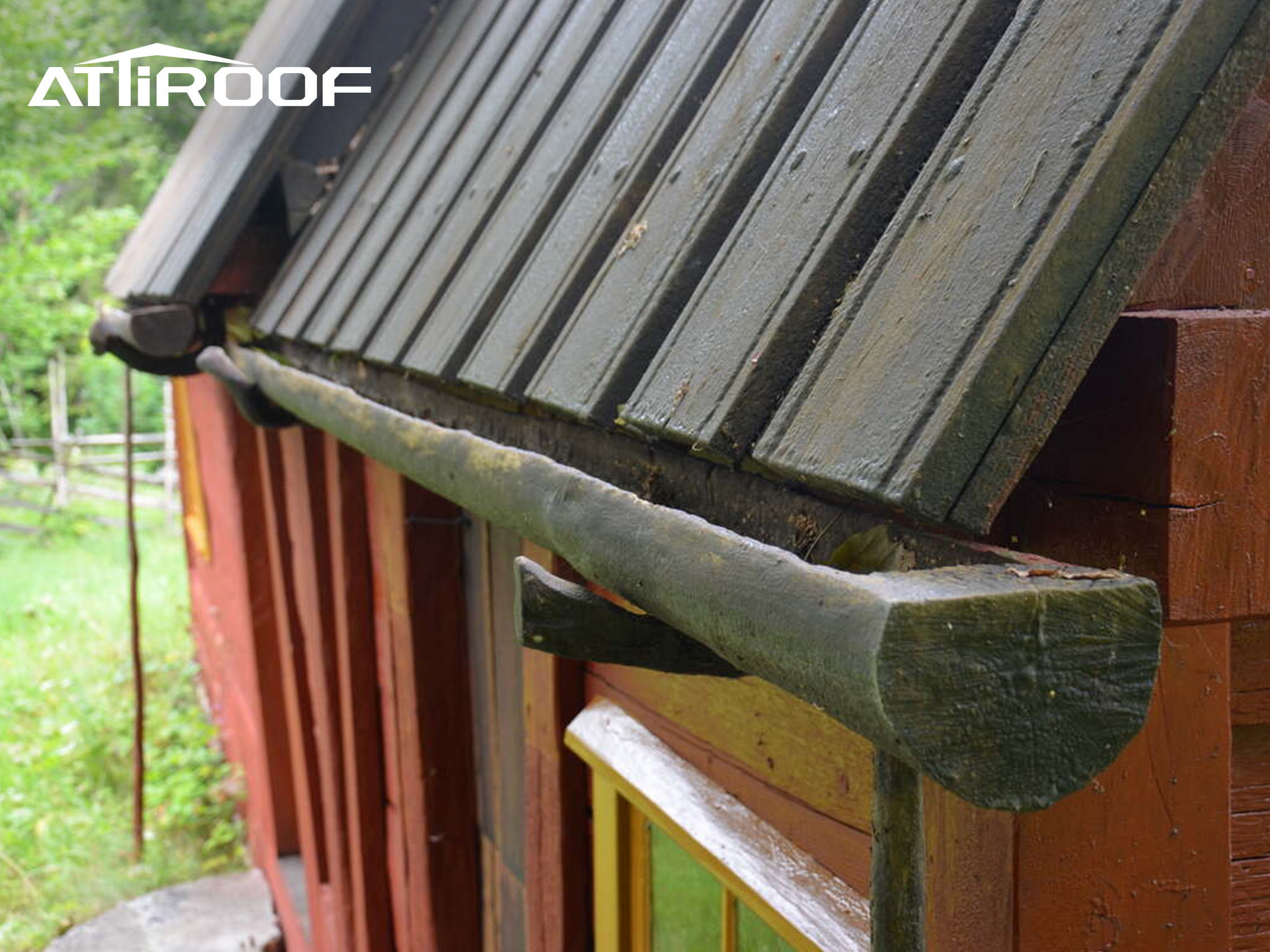
Wood gutters embody a classic and traditional aesthetic, offering a natural charm that is hard to replicate with modern materials. At Attiroof, we understand that for some homeowners, the authenticity and rustic appeal of wood gutters make them a preferred choice, especially for historic homes or structures aiming to maintain a period-specific appearance.
Distinctive Features of Wood Gutters:
●Natural Aesthetic: Wood gutters bring a timeless elegance to any property. They blend seamlessly with the natural surroundings and are particularly suited for historic or traditionally styled homes, where maintaining architectural integrity is crucial.
●Custom Craftsmanship: Each wooden gutter is a testament to skilled craftsmanship. Unlike mass-produced gutter systems, wood gutters can be tailored to specific dimensions and shapes, offering a bespoke solution that adds to the uniqueness of a property.
●Insulative Properties: Wood naturally has insulative properties, potentially contributing to a more stable temperature near the roofline and reducing the likelihood of ice dam formation in colder climates.
Advantages of Opting for Wood Gutters:
●Aesthetic Harmony: For homes with wooden architectural elements, wood gutters ensure a harmonious look, preserving the property's cohesive appearance and potentially enhancing its market value.
●Eco-Friendly Material: Wood is a renewable resource, and for those conscientious about their environmental footprint, wood gutters can be a sustainable choice, especially if sourced from responsibly managed forests.
Considerations for Installing Wood Gutters:
●Regular Maintenance Required: Wood gutters demand diligent maintenance. They need to be cleaned, treated, and inspected regularly to prevent rot, mold, or water damage. Proper maintenance can significantly extend the lifespan of wood gutters but requires a commitment from the homeowner.
●Susceptibility to Elements: Although wood can be treated to resist water and pests, it is inherently more susceptible to the elements than metal or synthetic options. This susceptibility means that without regular upkeep, wood gutters can deteriorate more quickly.
●Professional Installation Recommended: Installing wood gutters is a skill-intensive task that often requires professional expertise. Proper installation is crucial to ensure that the gutters are not only aesthetically pleasing but also functionally effective.
In conclusion, wood gutters are an excellent choice for those who appreciate the natural beauty and traditional elegance they bring to a property. Ideal for homeowners who prioritize authenticity and are committed to the care and preservation of their home's unique character, these gutters offer an unmatched aesthetic. While they do require a more involved maintenance regimen compared to metal or synthetic alternatives, the distinct appeal and customized craftsmanship of wood gutters make them a compelling option for those looking to maintain or enhance the classic appearance of their home.
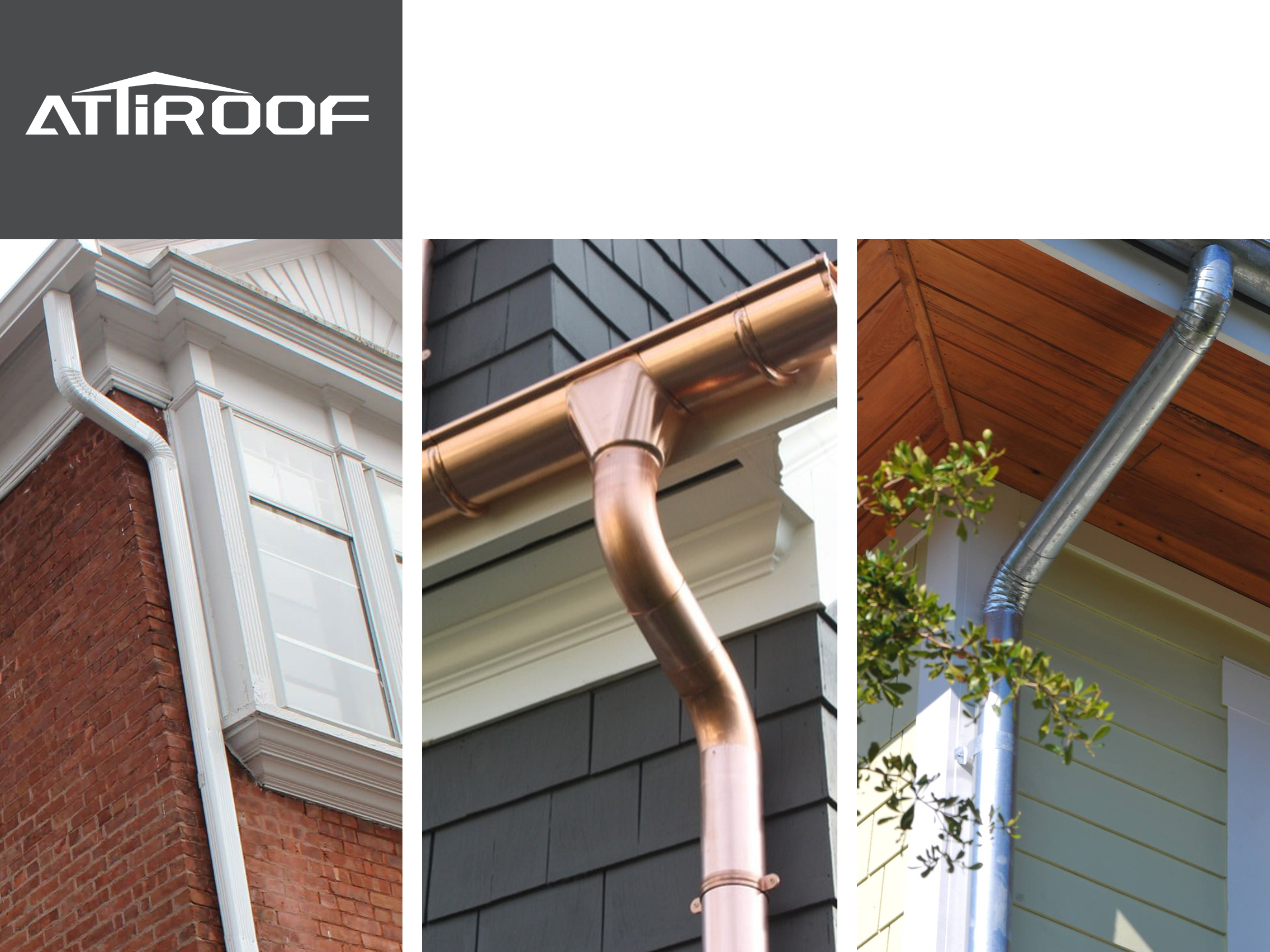
Having explored the diverse types of gutter systems, you might now have a clearer picture of the options available and perhaps even a preference in mind. However, before making a final decision, it's crucial to consider a range of key factors that will ensure your chosen gutter system not only meets your aesthetic desires but also performs optimally under your specific circumstances. At Attiroof, we're committed to guiding you through this decision-making process. Here's a breakdown of essential aspects to deliberate when selecting the ideal gutter system for your home:
1. Climate and Weather Conditions:
Your local climate plays a pivotal role in determining the most suitable type of gutter for your home. In areas prone to heavy rainfall, a robust system like seamless or K-style gutters, known for their capacity to handle large volumes of water, might be the ideal choice. Conversely, if you reside in a region with frequent snowfall, it's essential to opt for a gutter system that can bear the weight of snow and ice, such as half-round or steel gutters, which are known for their strength and structural integrity.
2. Material Durability and Maintenance:
Different materials offer varying levels of durability and maintenance needs. For instance, while vinyl gutters are low-maintenance and rust-resistant, they may not be as durable as metal options like steel or copper in extreme weather conditions. Consider how much time and effort you are willing to invest in maintenance when choosing the material.
3. Aesthetic Appeal:
Gutters not only serve a functional purpose but also contribute to the overall look of your home. The style and color of the gutters should complement your home's exterior. Materials like copper and wood offer distinctive looks but come with different maintenance and cost implications.
4. Budget and Cost-effectiveness:
It's vital to balance the initial cost with long-term value. While options like vinyl are budget-friendly upfront, they may incur higher maintenance costs over time. In contrast, premium materials like copper, though pricier initially, are noted for their longevity and can enhance property value, often making them more cost-effective in the long run. According to industry data, well-maintained copper gutters can last over 50 years, significantly reducing the need for replacements.
5. Environmental Considerations:
If sustainability is important to you, consider the environmental impact of the gutter material. Materials like aluminum and steel are often made from recycled content and are fully recyclable at the end of their life.
6. Professional Installation and Warranty:
Proper installation is crucial for the optimal performance of your gutter system. Incorrectly installed gutters can lead to issues like water damage or foundation problems. Choose a reputable company that offers professional installation services and a solid warranty on their products.
7. Water Collection and Recycling:
If you're considering rainwater harvesting, opting for gutter systems like seamless or half-round gutters can be beneficial, as their efficient design minimizes leaks and ensures maximum water capture. Pairing these gutters with rain barrels or cisterns not only contributes to water conservation but can also lead to significant savings on your water bills. These gutter types are known for their smooth contours, which facilitate optimal water flow and reduce debris accumulation, making them ideal for collecting and repurposing rainwater.
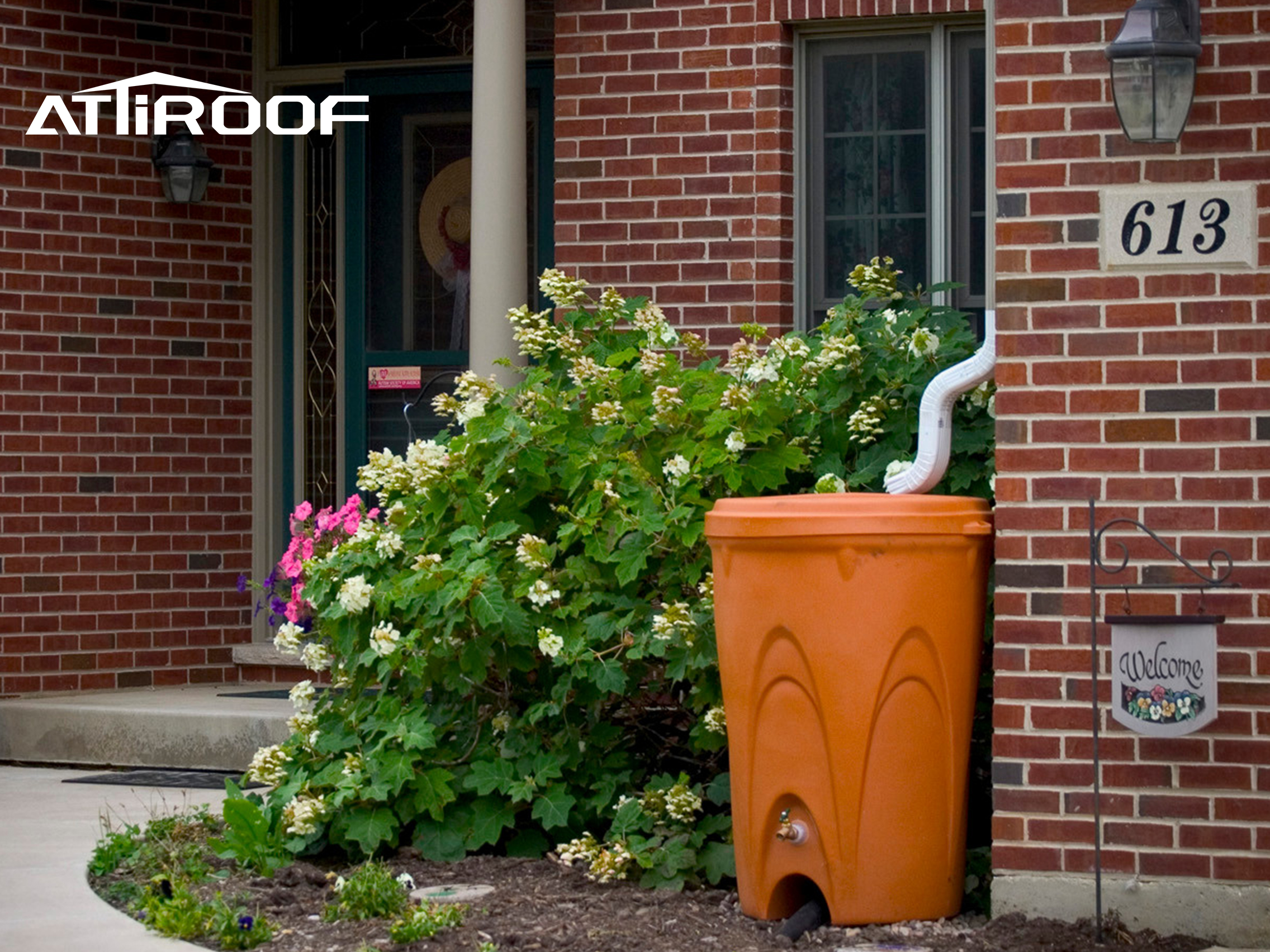
By carefully considering these factors, you can choose a gutter system that not only protects your home from water damage but also aligns with your aesthetic preferences, budget, and environmental values. Remember, a well-chosen gutter system is an investment in your home's health and longevity.
Selecting the ideal material for your gutter system goes beyond mere aesthetics; it's about finding the perfect amalgamation of durability, functionality, and cost efficiency that stands the test of time. The quest for the best materials is not just about what looks good, but what genuinely works best for your home in the long run. In this section, we delve into an array of materials commonly harnessed in gutter systems, dissecting why certain materials rise above others in terms of performance, longevity, and overall value. At Attiroof, we aim to demystify these choices, helping you navigate through the pros and cons of each material to pinpoint the one that best fulfills your roofing needs and why it does so.
Gutter systems can be crafted from a variety of materials, each offering unique characteristics and benefits. Here's an overview of the most commonly used materials in gutter systems:
1. Aluminum Gutters:
Aluminum is widely favored for its lightweight nature, rust resistance, and versatility. It's available in a range of colors and can be easily shaped to fit any gutter style. Its durability under various weather conditions makes it a popular choice among homeowners.
2. Vinyl Gutters:
Known for their ease of installation and low cost, vinyl gutters are a go-to for DIY enthusiasts. They are resistant to rust and corrosion and come in various colors. However, vinyl may become brittle and prone to cracking in extremely cold temperatures.
3. Steel Gutters:
Steel gutters are celebrated for their strength and sturdiness, making them suitable for climates with heavy snowfall or severe weather. They can be galvanized to prevent rust, but they do require regular maintenance to prevent corrosion.
4. Copper Gutters:
Offering a blend of exceptional durability and timeless beauty, copper gutters age gracefully, developing a patina over time. They are highly resistant to corrosion and can last for decades, but this longevity comes with a higher price tag.
5. Zinc Gutters:
Zinc gutters are known for their longevity, durability, and the ability to develop a protective patina. They require minimal maintenance and can last for decades. Like copper, zinc is a premium material and is more costly upfront but offers long-term value.
6. Wood Gutters:
While not as common today, wood gutters are sometimes used in historic renovations or custom projects. They offer a traditional aesthetic but require significant maintenance to prevent rot and water damage.
Each of these materials has its own set of advantages and considerations. The choice of material will significantly influence the performance, maintenance requirements, and overall aesthetic of your gutter system. In the following sections, we will explore the advantages and disadvantages of these materials in more detail, helping you determine which gutter material is the best fit for your roofing needs.
 Selecting the right material for your gutter system is a decision that greatly affects the functionality, longevity, and appearance of your home. Understanding the advantages and disadvantages of each material can guide you in making an informed choice. Below, we explore the pros and cons of some of the most popular gutter materials.
Selecting the right material for your gutter system is a decision that greatly affects the functionality, longevity, and appearance of your home. Understanding the advantages and disadvantages of each material can guide you in making an informed choice. Below, we explore the pros and cons of some of the most popular gutter materials.
Aluminum Gutters:
●Advantages:
Aluminum gutters are lightweight, rust-resistant, and easy to install. They come in a wide range of colors and can be customized to fit any gutter style. Their versatility and resistance to weather make them a widely preferred choice.
●Disadvantages:
Though durable, aluminum can dent or bend under impact. It may also not be as robust in extremely cold climates, where it can be prone to cracking.
Vinyl Gutters:
●Advantages:
Vinyl gutters are the most cost-effective option (typically ranging in price from $3 to $5 per linear foot), resistant to rust and corrosion, and are the easiest to install, often making them ideal for DIY projects.
●Disadvantages:
Vinyl gutters, while cost-effective, may become brittle and crack in cold weather, and generally have a shorter lifespan of about 10 to 20 years compared to metal options.
Steel Gutters:
●Advantages:
Steel is one of the sturdiest materials, capable of withstanding heavy rain, snow, and wind. It's less likely to dent compared to aluminum.
●Disadvantages:
Steel is susceptible to rust if not properly treated and is notably heavier, typically weighing about 9-10 pounds per foot, requiring more robust support, and is generally more expensive.
Copper Gutters:
●Advantages:
Copper gutters are exceptionally durable and can last for decades. They develop a beautiful patina over time and can significantly enhance the aesthetic appeal and value of your property.
●Disadvantages:
Copper, costing between $15 to $25 per linear foot, is one of the most expensive gutter materials, requires professional installation, and its patina process may not suit all tastes.
Zinc Gutters:
●Advantages:
Like copper, zinc gutters are durable and have a long lifespan. They require minimal maintenance and develop a protective patina that shields them from rust and corrosion.
●Disadvantages:
Zinc gutters, priced around $10 to $20 per linear foot, also have a higher cost and require professional installation, with a patina appearance that may not appeal to everyone.
Wood Gutters:
●Advantages:
Wood gutters offer a traditional and natural aesthetic that can be perfect for historical restorations or specific architectural styles.
●Disadvantages:
Wood requires extensive maintenance to prevent rot, warping, or water damage. It's less durable than metal options and typically more expensive due to the craftsmanship involved.
In conclusion, each gutter material has its own set of advantages and drawbacks. Your choice should be guided by factors such as your local climate, the architectural style of your home, maintenance capacity, and budget. Understanding these aspects will help you choose a gutter system that not only looks great but also provides lasting protection for your home.

The design of your gutter system plays a critical role in both the aesthetics and functionality of your home's roofing. A well-designed gutter system not only protects your home from water damage but also complements and enhances the architectural style of your property. In this section, we delve into the intricate balance between aesthetics and function in gutter design, exploring how a thoughtful approach can lead to a harmonious integration with your home's overall appearance while ensuring optimal performance.
A harmonious blend of aesthetics and functionality is the hallmark of effective gutter design. While the primary purpose of gutters is to channel water away from your home's foundation, their impact on the visual appeal of your property is undeniable. Attiroof understands the importance of this balance and offers solutions that cater to both needs simultaneously.
●Aesthetic Considerations:
The choice of material, color, and style of gutters should complement the architectural character of your home. Whether it's the rustic charm of wood, the sleek look of aluminum, or the timeless elegance of copper, the right gutter can accentuate your home's design features. Additionally, the shape and size of the gutters should be proportionate to the roofline, ensuring a seamless integration with the home's exterior.
●Functional Imperatives:
Beyond aesthetics, the design of the gutter system must ensure efficient water management. This includes considerations for the gutter's size and shape, which determine its capacity to handle rainfall intensity specific to your region. The positioning and slope of the gutters are also crucial for effective water flow and to prevent clogging or water overflow, which can lead to water damage.
●Innovative Solutions:
Advances in gutter design, such as seamless gutters or gutter guards, offer enhanced functionality while maintaining a clean and polished look. Seamless gutters minimize leaks and require less maintenance, while gutter guards prevent debris accumulation, ensuring that aesthetics are not compromised by functional necessities.
●Customization and Integration:
At Attiroof, we recognize that every home is unique. Customized gutter solutions allow for a perfect match with your home's style and functional requirements. Expertly integrating the gutter system with the roof and the home's exterior ensures that the gutters are not just an addition but a complementary extension of your home.
The impact of gutter design on roof aesthetics is not merely theoretical; numerous real-life examples highlight how a well-chosen gutter system can elevate the appearance of a home. In this section, we explore case studies where gutter design has played a pivotal role in enhancing roof aesthetics, offering tangible insights into the transformative power of thoughtfully selected gutter systems.
Case Study 1: Modern Home with Seamless Aluminum Gutters
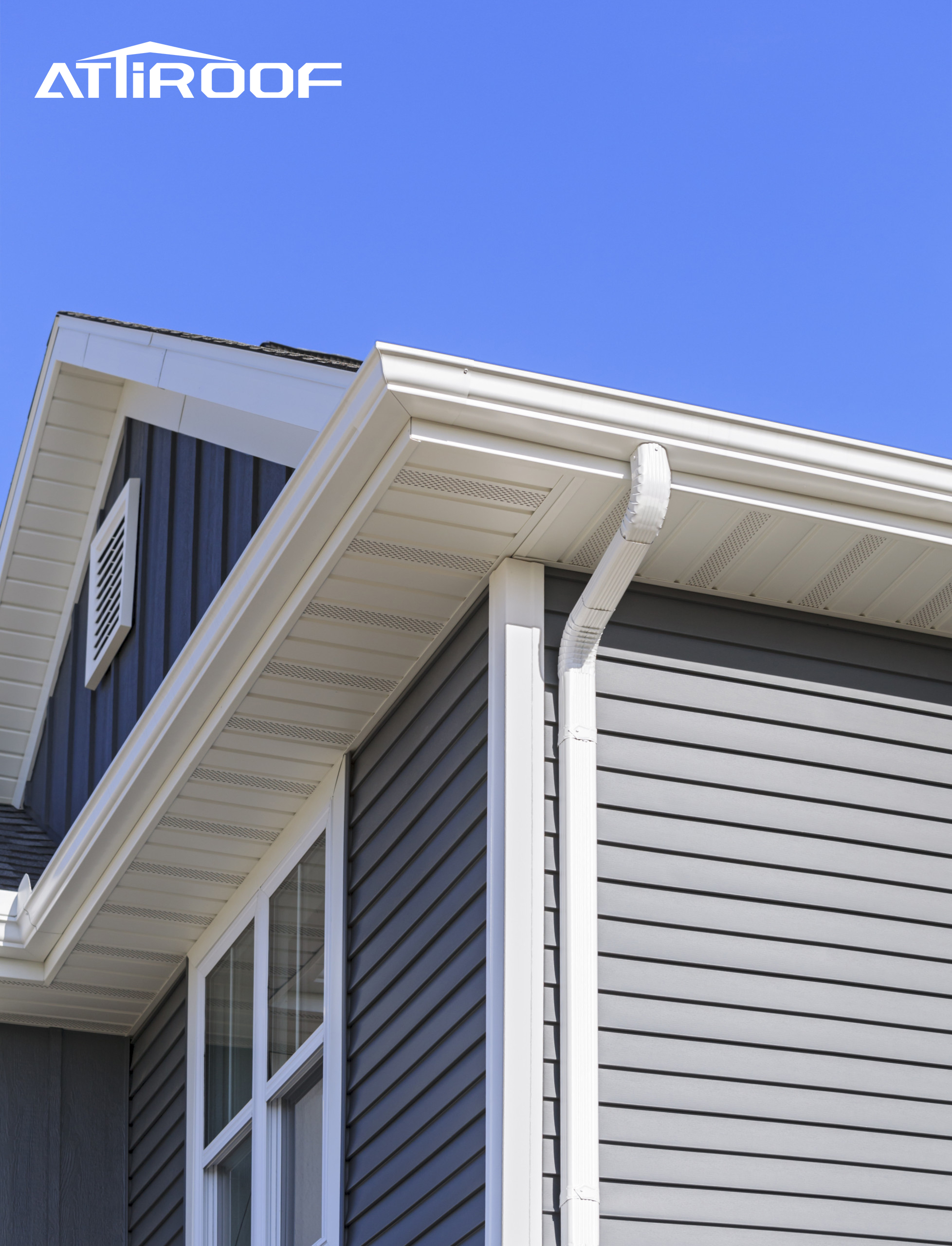
●Overview:
A modern home with clean lines and a minimalist aesthetic opted for seamless aluminum gutters. The goal was to complement the sleek architecture without drawing undue attention to the gutter system.
●Result:
The seamless gutters provided a smooth, uninterrupted finish that aligned perfectly with the home's modern design. The color of the gutters was matched with the trim of the house, creating a cohesive and subtle appearance. The functional aspect was not compromised, as the seamless design minimized leaks and required less maintenance.
Case Study 2: Historic Renovation with Copper Gutters
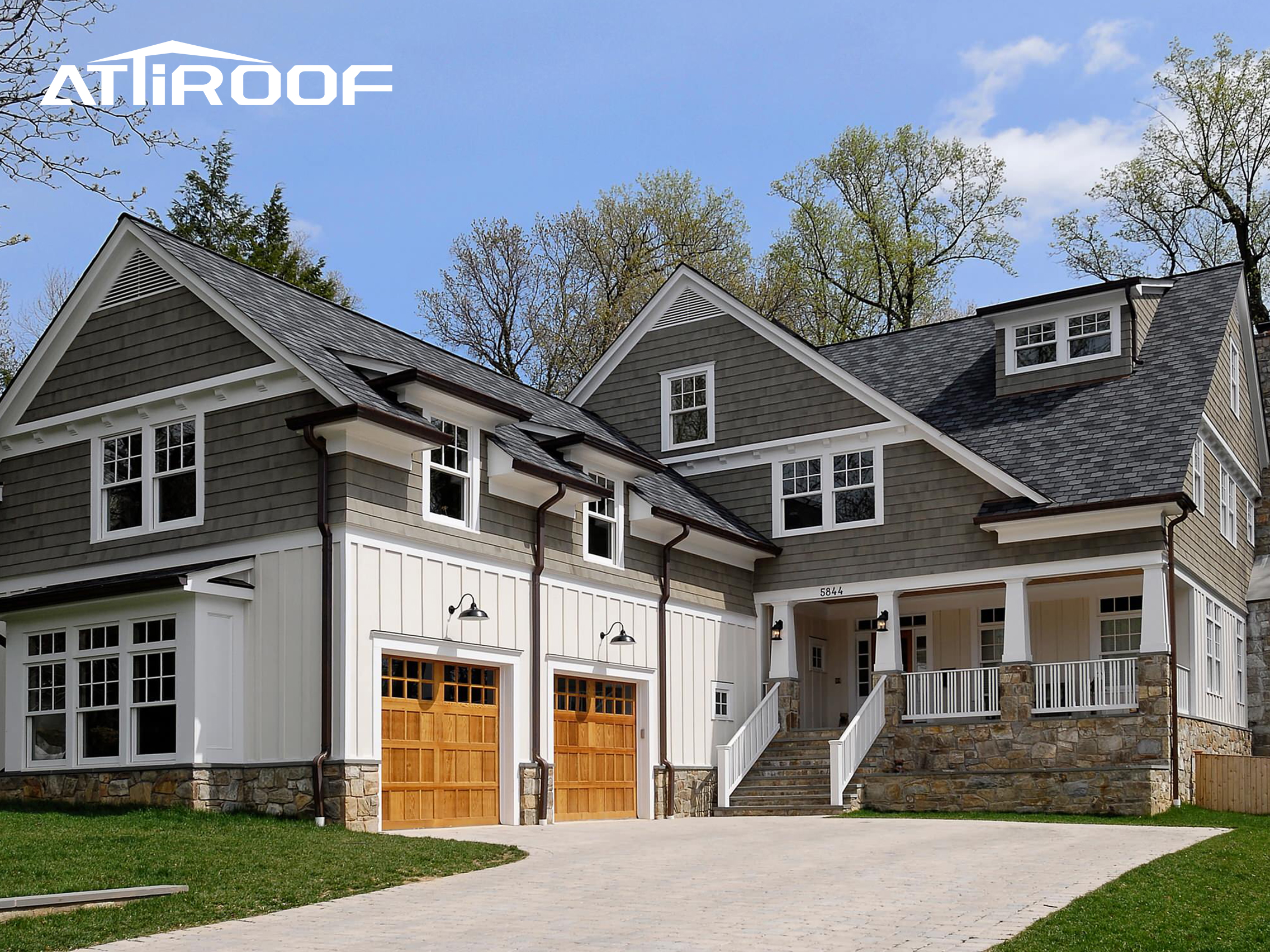
●Overview:
A historic Victorian home underwent a renovation, and the choice of gutter system was crucial to maintain its authentic look. The owners chose copper gutters for their timeless appeal and durability.
●Result:
The copper gutters added an element of classic elegance to the home. As they aged, they developed a beautiful patina, further enhancing the historic look of the property. The durability of copper ensured that the gutters would last for decades, aligning with the long-term preservation goals of the renovation.
Case Study 3: Country Cottage with Wood Gutters
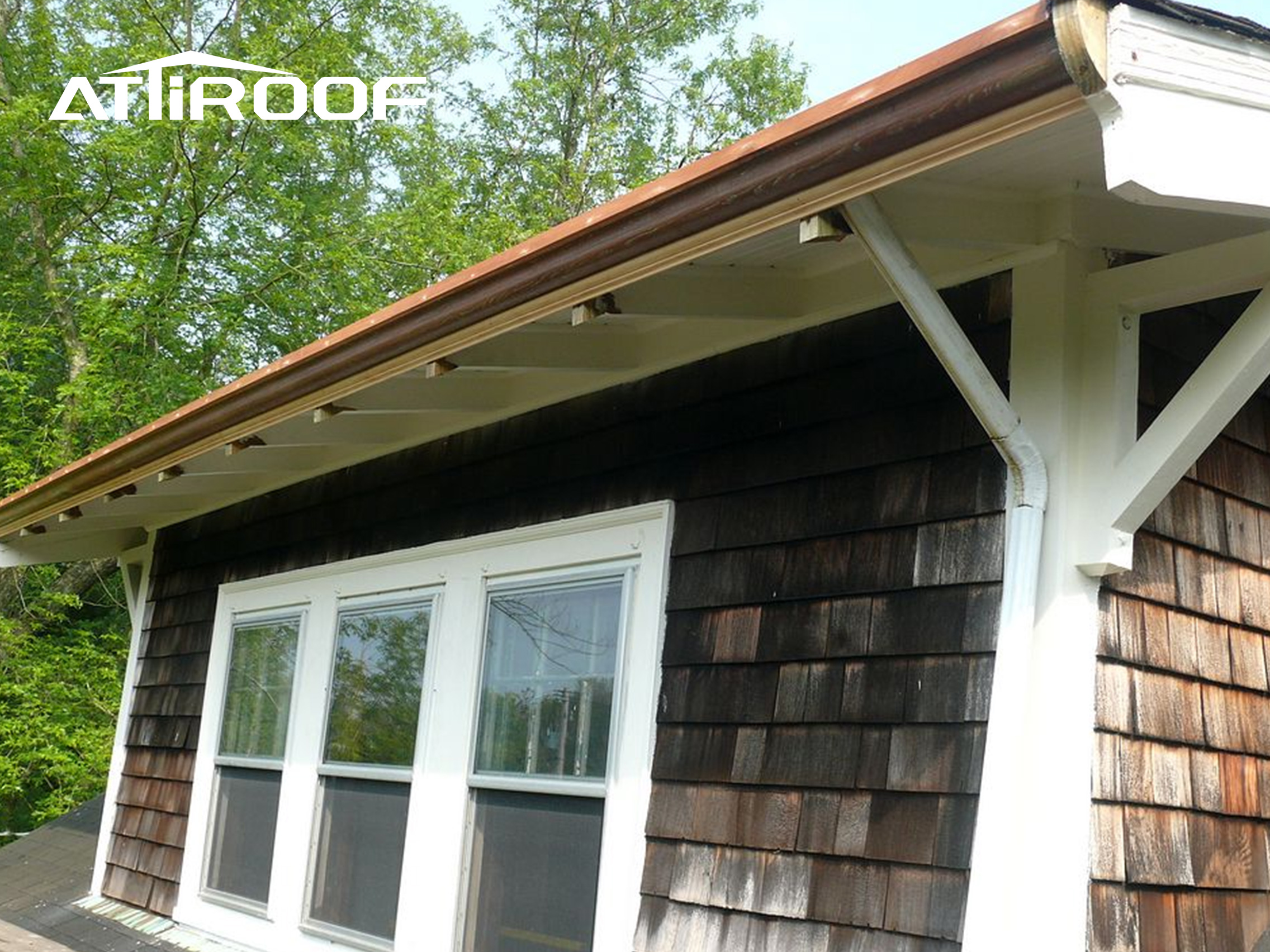
●Overview:
A charming country cottage with a rustic aesthetic required a gutter system that would complement its natural wood siding and rural setting.
●Result:
The installation of wood gutters was a perfect match for the cottage, enhancing its rustic charm. The wood gutters blended seamlessly with the home's exterior, preserving the natural look while providing effective water management. Regular maintenance ensured that the wood gutters remained functional and visually appealing.
These case studies illustrate that the right gutter design can significantly enhance the roof's appearance while fulfilling its functional role. Whether it's the seamless integration with modern architecture, the classic enhancement of historic homes, or the natural complement to rustic settings, gutter systems play a crucial role in the overall aesthetic of a property. Attiroof is dedicated to providing gutter solutions that not only meet the functional needs of your home but also contribute positively to its visual appeal, ensuring that every aspect of your roofing system is in harmony.
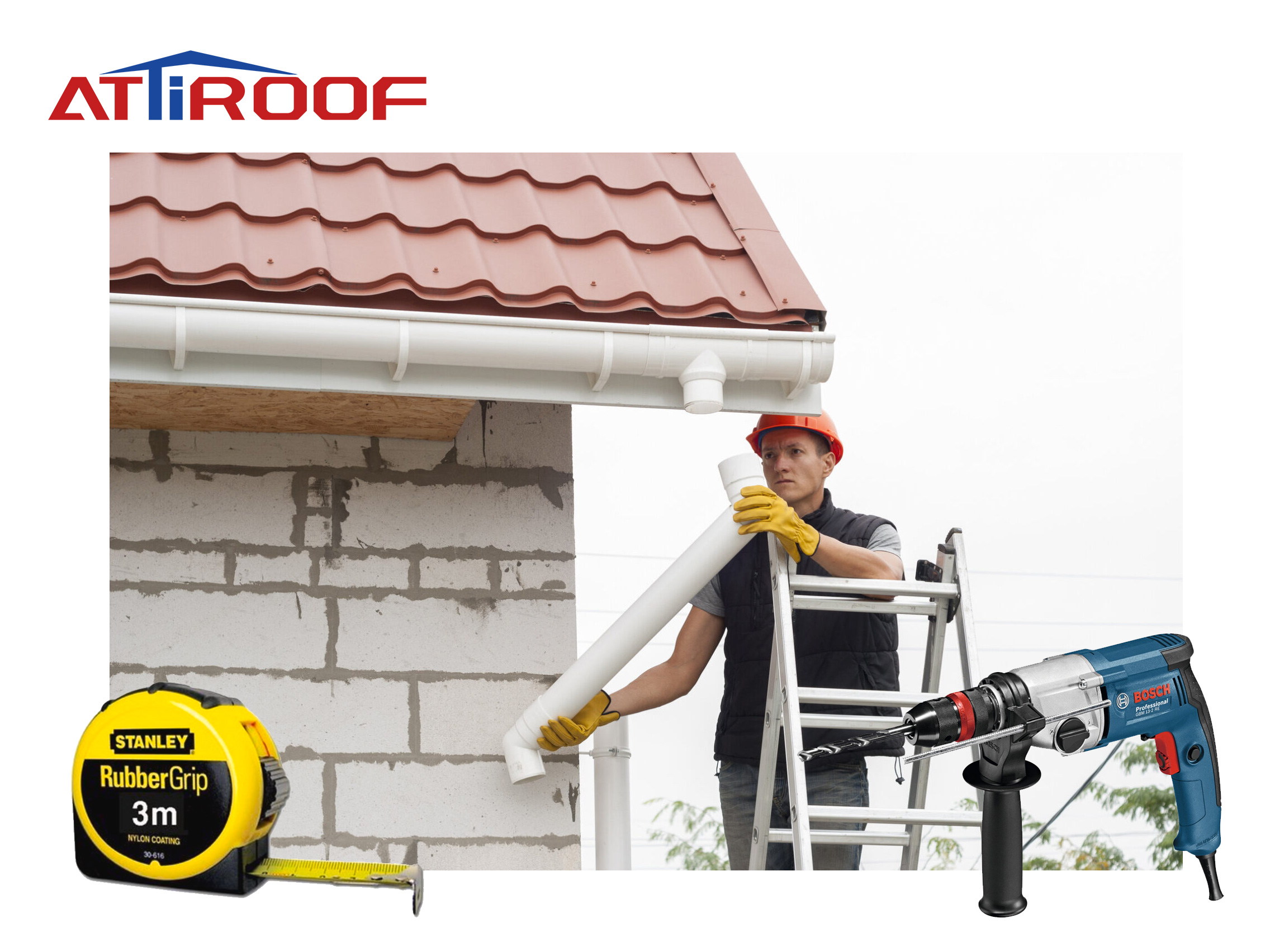
Installing a gutter system is a critical process that ensures the effective management of water runoff from your roof, safeguarding your home against potential water damage. This process, while seemingly straightforward, involves meticulous planning, precise measurement, and skilled execution.
Whether you're considering a professional installation or a DIY project, understanding the fundamental steps of gutter installation can help ensure a successful outcome. In this section, we provide a detailed, step-by-step guide to gutter installation, followed by insights into the pros and cons of professional versus DIY approaches.
Step 1: Planning and Preparation
●Tools Needed: Tape measure, ladder.
●Assess the home's roof size and shape to determine the length and type of gutters required.
●Select the gutter material and style that aligns with your home's design and local climate.
Step 2: Measuring and Calculating
●Tools Needed: Tape measure, chalk line.
●Accurately measure the roof's edge to calculate the total gutter length needed.
●Plan the downspouts' placement, ensuring water is directed away from the foundation.
Step 3: Gutter Sections Preparation
●Tools Needed: Hacksaw or tin snips, file or sandpaper.
●For sectional gutters, cut the gutter material to the measured lengths, ensuring a snug fit.
●For seamless gutters, take precise measurements to a professional for custom fabrication.
Step 4: Setting up Fascia and Mounting Brackets
●Tools Needed: Hammer, power drill, screws, level.
●Inspect and repair any damaged fascia boards.
●Install gutter mounting brackets along the roof's edge, ensuring proper alignment and spacing for optimal support.
Step 5: Gutter Installation
●Tools Needed: Power drill, rivet gun (for aluminum gutters), sealant.
●Attach the gutter sections to the mounting brackets securely.
●Confirm that gutters are installed with a slight incline towards the downspouts for effective water flow.
Step 6: Downspout Assembly and Attachment
●Tools Needed: Power drill, screws, rivet gun (for aluminum downspouts), sealant.
●Connect downspout sections and secure them to the gutter outlet.
●Ensure downspouts extend sufficiently from the house to prevent water pooling near the foundation.
Step 7: Final Inspection and Testing
●Tools Needed: Hose or bucket of water.
●Conduct a thorough inspection of the gutter system for proper alignment and secure fittings.
●Perform a water test to confirm there are no leaks and water flows smoothly towards and through the downspouts.
While this guide provides a general overview, the specifics can vary based on the gutter type and the architectural design of the home. For those who choose the DIY route, having the correct tools and understanding the process is vital. However, for more complex installations or to guarantee top-notch quality, seeking professional installation is often the best choice. In the next section, we'll delve into the factors to consider when deciding between professional or DIY gutter installation.
When it comes to installing a gutter system, homeowners often face the decision between embarking on a DIY project or hiring professionals. Both approaches have their merits and limitations, and the right choice depends on various factors including skill level, budget, and the complexity of the installation. Here we break down what you need to know about professional versus DIY gutter installation.
Professional Installation:
●Advantages:
1. Expertise and Experience:
Professionals bring years of experience, ensuring that the installation is done correctly and efficiently. They are well-versed in dealing with unexpected challenges that may arise during the process.
2. Quality and Warranty:
Professional installers typically offer a warranty on their workmanship. The quality of installation is usually higher, which can extend the lifespan of your gutter system.
3. Safety:
Working at heights can be dangerous. Professionals are trained and equipped with the necessary safety gear to work safely on ladders or roofs.
4. Time-saving:
Hiring professionals can significantly reduce the time taken to install your gutter system.
●Considerations:
Cost: Professional installation is more expensive than DIY. However, the investment might be worth it considering the potential long-term benefits and reduced risk of errors.
DIY Installation:
●Advantages:
1. Cost Savings:
The most apparent benefit of DIY installation is the cost savings on labor. If you have the necessary tools, you can further minimize expenses.
2. Flexibility:
You can work at your own pace and on your own schedule.
3. Personal Satisfaction:
Completing a home improvement project on your own can provide a sense of achievement and personal satisfaction.
●Considerations:
1. Risk of Mistakes:
Without proper knowledge and experience, the risk of making mistakes that could compromise the functionality of your gutter system increases.
2. Safety Concerns:
Working on ladders or at heights can be hazardous without the proper safety equipment and expertise.
3. Time and Effort:
A DIY project can be time-consuming, especially if you are learning as you go.
In conclusion, the choice between professional and DIY gutter installation hinges on weighing the cost against the benefits of professional expertise, safety, and time. For those with the necessary skills and tools, a DIY approach can be a rewarding and cost-effective option. However, for complex installations or for those who prefer a guarantee of quality and safety, professional installation is the advisable path. Understanding the scope of your project and realistically assessing your capabilities and risks is crucial in making the right decision for your home's gutter installation.
Maintaining and cleaning your gutter system is essential to ensure its longevity and functionality. Neglected gutters can lead to severe issues like water damage to your home's foundation, landscaping erosion, and roof damage. A well-maintained gutter system not only protects your home but also saves you money in the long run by preventing costly repairs. In this section, we'll share some effective strategies for maintaining and cleaning your gutter system, providing you with the knowledge to keep your gutters in optimal condition throughout the year.
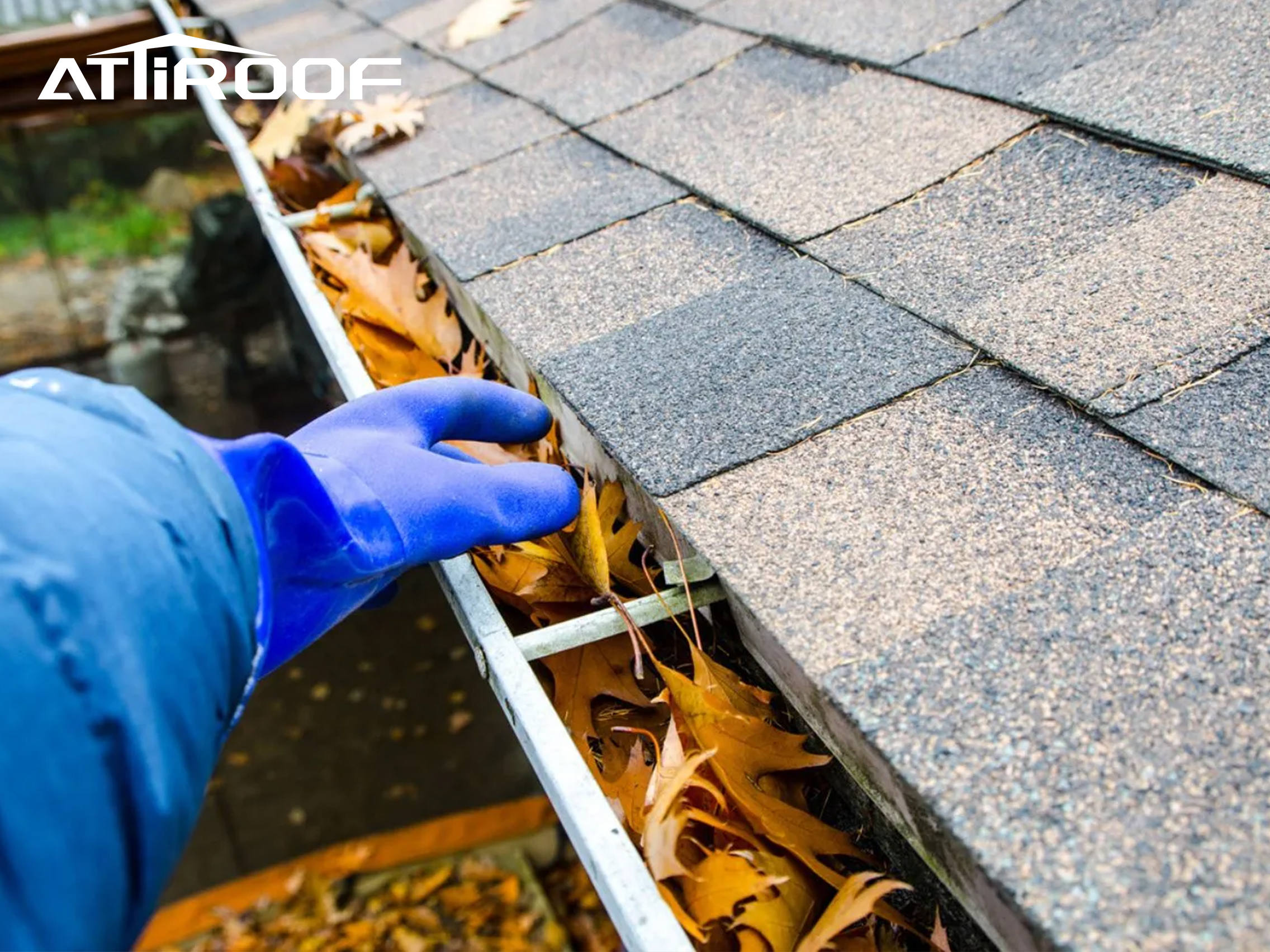
Regular maintenance is key to a well-functioning gutter system. Here are some routine gutter maintenance tips to help you keep your gutters in top shape:
1. Regular Inspections:
●Schedule gutter inspections at least twice a year, typically in the spring and fall. Check for any signs of damage, sagging, or blockage.
●After a heavy storm, inspect your gutters for any accumulated debris or damage caused by the weather.
2. Clearing Debris:
●Remove leaves, twigs, and any other debris from the gutter channels. This can be done using a gutter scoop, garden trowel, or by hand (wearing gloves).
●Ensure the downspouts are clear. You can use a plumber's snake or a high-pressure hose to unclog downspouts.
3. Preventative Measures:
●Consider installing gutter guards to prevent debris from entering the gutters. They can significantly reduce the amount of time spent on cleaning.
●Trim tree branches hanging over your roof to minimize the amount of leaves and twigs falling into the gutters.
4. Checking for Leaks and Corrosion:
●Look for any signs of rust or holes in metal gutters. Small holes can be patched using a gutter patching kit or sealant.
●Ensure that all gutter joints are tightly sealed. Apply sealant to any leaking joints.
5. Ensuring Proper Gutter Alignment:
●Gutters should be securely attached to the fascia and have a slight slope towards the downspouts for proper drainage.
●Check the brackets or hangers holding the gutters to the fascia. Tighten any loose hardware.
6. Downspout Drainage:
●Make sure the water exiting the downspouts is directed away from the foundation of your house. You may use downspout extenders or splash blocks for this purpose.
●Ensure the soil around your home slopes away from the foundation to prevent water pooling.
By following these routine maintenance tips, you can significantly extend the life of your gutter system and protect your home from water-related issues. Regular maintenance not only ensures the functionality of your gutters but also contributes to the overall well-being of your home. In the next section, we'll explore some effective cleaning techniques to keep your gutters in pristine condition.
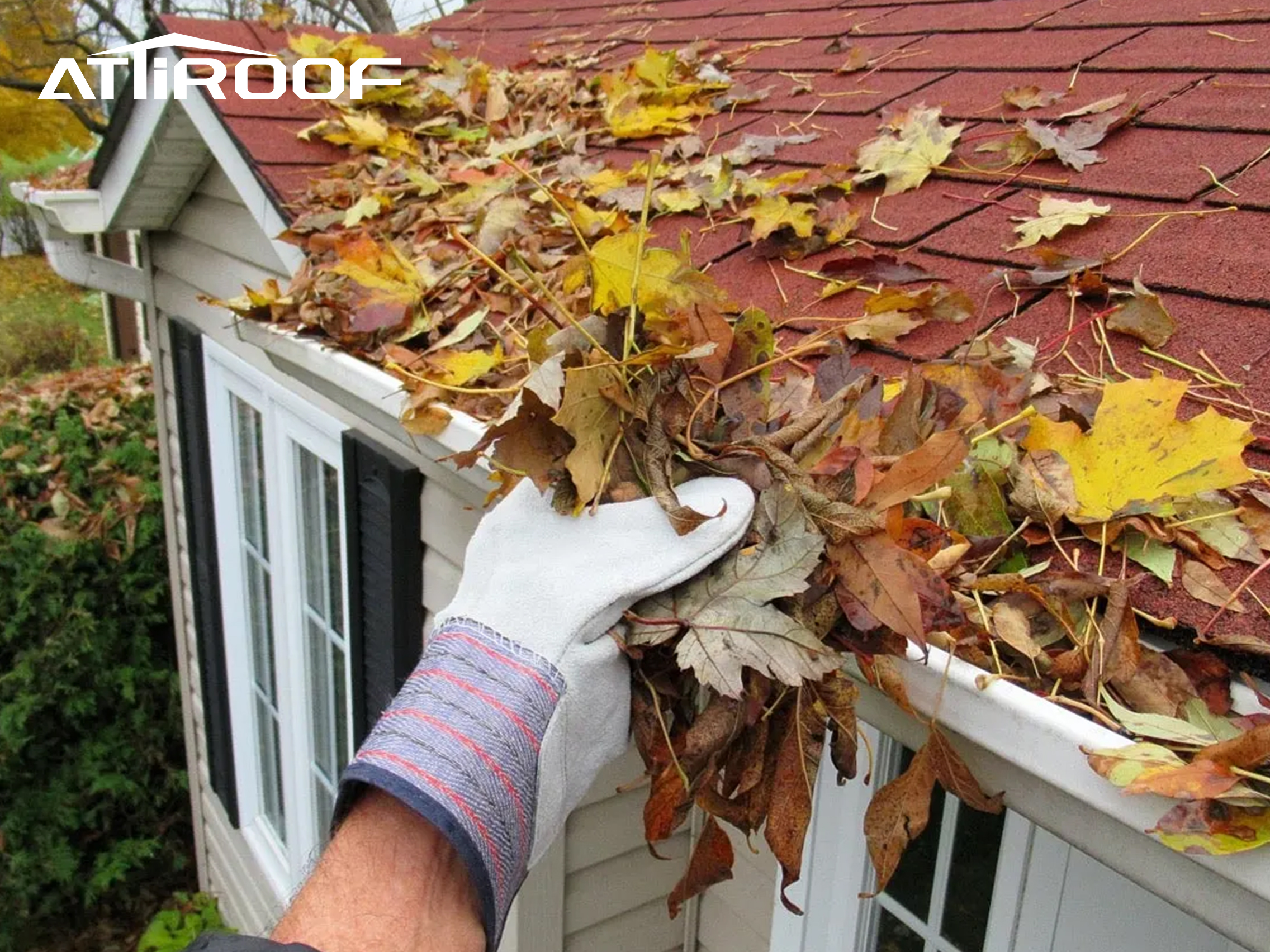
Keeping your gutters clean is not just about maintaining the appearance of your home; it's a vital practice to prevent water damage and extend the lifespan of your gutter system. Here are some effective techniques to clean your gutters thoroughly and safely:
1. Safety First:
●Use a sturdy ladder to safely reach your gutters. Ensure that the ladder is stable and, if possible, have someone spot you.
●Wear gloves to protect your hands from sharp objects and debris. Safety goggles and a dust mask are also recommended to protect against dust and mold.
2. Gutter Cleaning Tools:
●Equip yourself with a gutter scoop or a garden trowel for scooping out loose debris.
●A bucket or a plastic tarp can be used to collect the debris, keeping your lawn clean.
3. Manual Cleaning:
●Start near a downspout and begin removing debris from the gutter. Work away from the downspout so that you're not pushing additional debris into it.
●Be gentle to avoid damaging the gutters or the roof.
4. Flushing the Gutters:
●Once the debris is cleared, use a garden hose with a spray nozzle to flush out the gutters. Start from the end opposite the downspout.
●Flushing helps remove smaller particles and checks if the water is flowing properly through the gutters and downspouts.

5. Downspout Cleaning:
●If water doesn’t flow freely through the downspouts, they may be clogged. Use a plumber's snake to unclog them or disassemble the downspout, if necessary, to remove the blockage.
●After unclogging, flush the downspouts with water to ensure they are clear.
6. Inspect for Repairs:
●While cleaning, inspect your gutters for signs of wear, tear, or damage. Look for cracks, holes, rust, or sagging sections.
●Small holes or cracks can be repaired with gutter sealant, while larger issues may require parts of the gutter to be replaced.
7. Consider a Professional Cleaning Service:
●If your gutters are particularly high or you're not comfortable working on a ladder, consider hiring a professional gutter cleaning service.
●Professionals have the experience, tools, and safety equipment to efficiently clean and inspect your gutters.
By incorporating these cleaning techniques into your regular maintenance routine, you can ensure that your gutter system remains effective and functional. Regular cleaning not only prevents costly repairs but also protects your home from potential water damage, preserving the structural integrity and value of your property.
Gutters are a crucial component of your home's exterior, playing a vital role in directing rainwater away from your foundation and landscaping. However, like any part of a home, they are not immune to problems. Over time, various issues can arise that compromise the functionality of your gutter system, potentially leading to serious damage to your property. Understanding these common problems and knowing how to address them is key to maintaining the integrity of your gutter system and your home.
In this section, we'll identify frequent issues encountered in gutter systems and later discuss the solutions and preventative measures to tackle these challenges effectively.
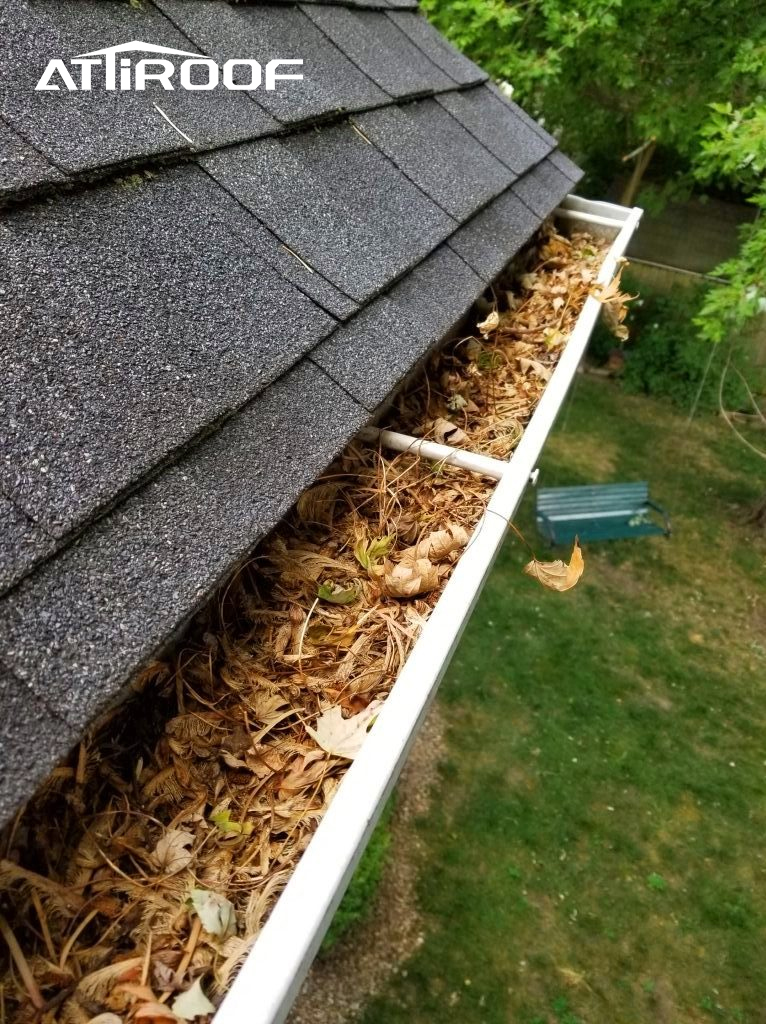
Awareness of the typical problems that can plague gutter systems is the first step towards ensuring their longevity and functionality. Here are some common issues that homeowners encounter:
1. Clogging:
The most prevalent issue in gutter systems is clogging caused by leaves, twigs, and other debris. Clogged gutters impede water flow, leading to overflow and potential water damage to your home.
2. Sagging Gutters:
Gutters may begin to sag due to the weight of accumulated debris, water, or snow. Sagging can affect the slope of the gutter, preventing water from flowing towards the downspouts.
3. Leaks and Holes:
Over time, gutters can develop leaks or holes due to corrosion, weather damage, or wear and tear. These issues can result in water escaping the gutter system and damaging the surrounding areas.
4. Improperly Pitched Gutters:
Gutters need a slight slope to ensure water flows towards the downspouts. If they are not correctly pitched, water can pool in the gutters, leading to overflow or standing water that can attract pests.
5. Downspout Issues:
Downspouts are critical for directing water away from your home's foundation. If they are blocked, disconnected, or not extended enough from the house, water can pool around the foundation, causing damage.
6. Gutter Joint Separations:
The joints between gutter sections can separate due to expansion and contraction from temperature changes or from the weight of debris and water. This separation can lead to leaks and inefficient water management.
7. Ice Dams and Snow Buildup:
In colder climates, ice dams can form in the gutters, blocking the flow of melting snow and water. The weight of ice and snow can also strain the gutter system, leading to potential damage.
Recognizing these issues early on and taking prompt action can prevent minor problems from escalating into major, costly repairs. In the following section, we will explore effective solutions and preventative measures to address these common gutter problems, ensuring your gutter system remains in optimal condition throughout the year.
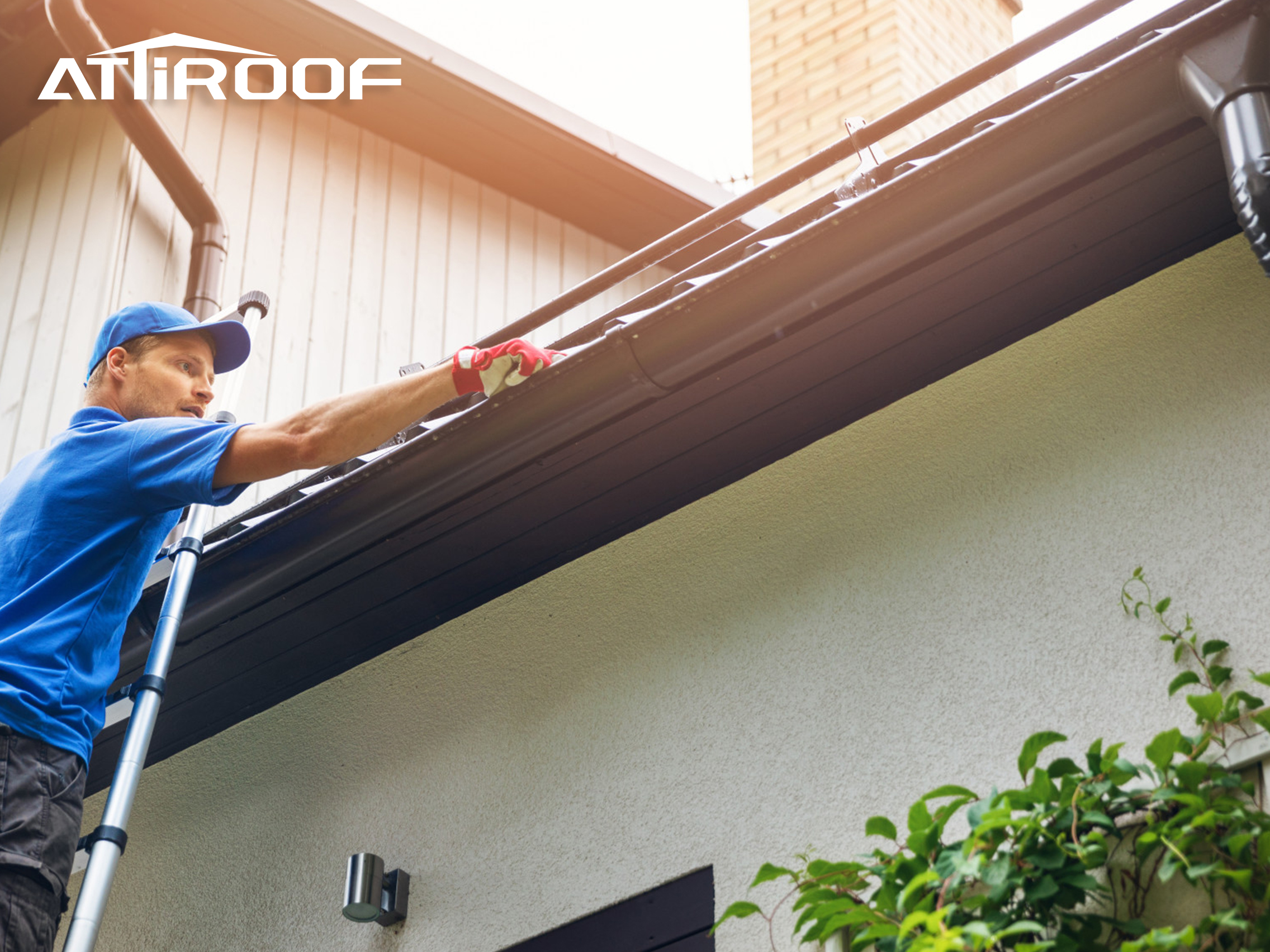
Addressing common gutter problems promptly and implementing preventative measures can significantly extend the lifespan of your gutter system and protect your home from potential damage. Below are solutions and preventative strategies for the common gutter issues identified earlier:
1. Solutions for Clogging:
●Regular Cleaning: Clean your gutters at least twice a year to remove leaves, twigs, and other debris. This routine should be more frequent if your home is surrounded by trees.
●Install Gutter Guards: Gutter guards can prevent debris from entering the gutter channels, significantly reducing the need for cleaning and the risk of clogs.
2. Fixing Sagging Gutters:
●Reinforce with Hangers: If gutters are sagging, they may need additional support. Install gutter hangers or spikes to reinforce them and maintain their proper slope and alignment.
●Ensure Correct Spacing: Spacing for hangers or spikes should typically be no more than 36 inches apart to provide adequate support.
3. Repairing Leaks and Holes:
●Sealant for Small Leaks: Apply gutter sealant from the inside to fix small leaks or holes. Ensure the gutter is dry and clean before applying.
●Patch for Larger Holes: For larger holes, use a metal patch of the same material as the gutter, and seal it in place with gutter sealant.
4. Correcting Improperly Pitched Gutters:
●Adjust the Slope: Gutters should have a slight slope towards the downspouts, typically 1/4 inch for every 10 feet. Readjust the gutter hangers to correct the slope if water is pooling.
5. Addressing Downspout Issues:
●Clear Blockages: Regularly check and clear out any debris blocking the downspouts.
●Extend Downspouts: Ensure downspouts extend at least 5 feet away from your home's foundation to prevent water pooling around the base of your house.
6. Resolving Gutter Joint Separations:
●Reattach or Replace: If gutter joints have separated, reattach them with gutter screws and sealant or replace the fittings if they are damaged.
7. Preventing Ice Dams and Snow Buildup:
●Proper Insulation and Ventilation: Ensure your attic is well insulated and ventilated to minimize the amount of heat reaching the roof.
●Install Heating Cables: Consider installing heating cables in your gutters and downspouts to prevent ice from forming.
By implementing these solutions and maintaining a regular inspection and maintenance schedule, you can prevent common gutter problems and ensure your gutter system functions effectively, protecting your home from water damage for years to come.
Remember, while some issues can be handled as DIY projects, others may require professional attention, especially if you're uncomfortable working at heights or the problem is complex.
The gutter system industry is not static; it's a field characterized by continuous innovation aimed at enhancing functionality, durability, and ease of maintenance. These advancements address common challenges like clogging, leakage, and wear while also aligning with aesthetic and environmental trends. This section sheds light on the cutting-edge technologies in gutter design, offering insights into how modern solutions are setting new standards in efficiency and sustainability.
The gutter industry's landscape is constantly evolving, with technological advancements enhancing efficiency, durability, and environmental sustainability. Here are some of the most notable innovations, supported by data and statistics where available:
1. Seamless Gutter Systems:
These systems have gained popularity due to their effectiveness in reducing leaks. A study by the National Association of Homebuilders suggests that seamless gutters have a significantly lower failure rate compared to traditional sectional gutters.
2. Gutter Guard Technology:
Advanced gutter guards, especially micro-mesh types, have been shown to reduce the frequency of gutter cleaning by up to 70%, according to consumer reports. These guards are designed to keep out even the smallest debris, ensuring unobstructed water flow.
3. Smart Gutter Systems:
The integration of IoT (Internet of Things) in home maintenance, including gutter systems, is on the rise. Market analysis predicts a growth rate of over 25% in the smart home industry by 2025, which includes advancements in smart gutter technologies.
4. Eco-Friendly Materials:
The use of recycled materials in gutter production is becoming more prevalent, with some manufacturers now using up to 85% recycled aluminum, significantly reducing the carbon footprint associated with new gutter installations.
5. Improved Downspout Designs:
Innovations such as wider and smoother downspouts have been shown to improve water flow efficiency by up to 30%, reducing the likelihood of blockages and overflow, according to industry studies.
6. Aesthetic Integration:
With the trend towards customization in home building, the demand for aesthetically pleasing gutters that complement a home's exterior has led to a broadening of color and style options. Reports indicate that homeowners are willing to invest up to 15% more for customized gutter solutions that enhance curb appeal.
These data-backed advancements underscore the gutter industry's commitment to innovation, offering homeowners solutions that are not only functionally superior but also align with broader trends in sustainability and home automation. As the industry continues to evolve, these technologies are expected to set new benchmarks in gutter design and functionality.
The gutter system industry is not only adapting to current demands but is also looking ahead, anticipating future needs and trends. The focus is shifting towards creating gutter systems that are more efficient, environmentally friendly, and integrated with smart home technologies. Here are some of the emerging trends that are expected to shape the future of gutter systems:
1. Sustainable Materials and Practices:
●The trend towards sustainability is expected to grow, with more gutter systems being made from recycled materials. Additionally, the manufacturing processes are anticipated to become more environmentally friendly, reducing the carbon footprint.
●Rainwater harvesting capabilities might become a standard feature in new gutter designs, promoting water conservation and self-sufficiency in residential properties.
2. Increased Smart Technology Integration:
●Smart gutters equipped with sensors for leak detection, temperature monitoring, and automated cleaning are expected to become more prevalent. These systems can alert homeowners about system status and maintenance needs through smartphone apps.
●IoT integration is likely to extend further, with gutter systems being part of a holistic home management system, capable of communicating with other smart devices for optimized home maintenance.
3. Advanced Gutter Protection Systems:
●Innovations in gutter guards and protection systems will continue, focusing on improving durability and the effectiveness of keeping debris out while allowing water to flow freely.
●Materials that actively resist the accumulation of debris or use advanced coatings to prevent ice and snow buildup are expected to become more common.
4. Customization and Aesthetic Options:
●As homeowners seek more customization options, the industry is likely to respond with a wider array of color choices, styles, and materials that blend seamlessly with any architectural design.
●The aesthetics of gutters will become as important as their functionality, with design elements that enhance the overall appearance of the home's exterior.
5. Climate-Adaptive Designs:
●With changing climate patterns, gutter systems will need to adapt to handle extreme weather conditions. This includes designs that can manage heavy rainfall, withstand high winds, and prevent ice dam formation in colder regions.
●Materials that are more resilient to UV exposure, temperature fluctuations, and severe weather conditions will be in higher demand.
6. Enhanced Installation and Maintenance Services:
●The industry might see a shift towards offering more comprehensive service packages, including installation, regular maintenance, and repair services, providing homeowners with peace of mind and hassle-free gutter management.
●DIY-friendly gutter systems that are easy to install and maintain might also become more prevalent, catering to the growing market of homeowners who prefer to handle home improvement projects themselves.

These future trends reflect a movement towards more innovative, sustainable, and homeowner-friendly gutter systems. As technology and material science continue to advance, gutter systems are set to become an even more integral and dynamic component of modern roofing, offering solutions that meet and exceed the evolving needs and preferences of homeowners.
In an era where environmental consciousness is more important than ever, the role of gutter systems in promoting sustainability and minimizing ecological impact is garnering increased attention.
Gutter systems, traditionally seen as a functional element of roofing, are now being recognized for their potential in eco-friendly initiatives. This section discusses how innovative gutter designs and practices not only protect your home but also contribute positively to environmental sustainability.
The integration of eco-friendly features into gutter systems is transforming them into tools for environmental conservation. Here are some key aspects through which gutter systems are promoting sustainability:
1. Materials and Manufacturing:
●Recycled Materials: Many gutter systems are now made from recycled materials, significantly reducing the demand for raw resources and the carbon footprint associated with their production. For instance, aluminum gutters often contain a high percentage of post-consumer recycled content.
●Sustainable Production Processes: Manufacturers are adopting more sustainable practices, including using renewable energy sources and reducing waste during the production of gutter systems.
2. Energy Efficiency:
Gutter systems, especially those integrated with roofing materials with reflective properties, can contribute to reduced energy consumption in homes. By minimizing heat absorption, these systems help maintain stable indoor temperatures, reducing the need for air conditioning.
3. Durability and Longevity:
Investing in high-quality, durable gutter systems reduces the frequency of replacements and repairs, thereby minimizing waste and resource consumption. Materials like copper and high-grade steel, known for their longevity, are becoming popular choices for environmentally conscious homeowners.
4. Low-Maintenance Solutions:
Gutter systems designed to be low-maintenance, such as those with gutter guards or advanced coating technologies, reduce the need for cleaning agents and repairs, further diminishing the ecological footprint.
5. Eco-Friendly Disposal:
At the end of their lifecycle, materials like aluminum and copper used in gutter systems are completely recyclable, ensuring that they don't contribute to landfill waste.
By incorporating these eco-friendly aspects, gutter systems not only protect your home from water damage but also play a part in conserving natural resources and reducing environmental impact. In the following section, we'll delve deeper into how gutter systems can be optimized for rainwater harvesting, further contributing to sustainable living practices.
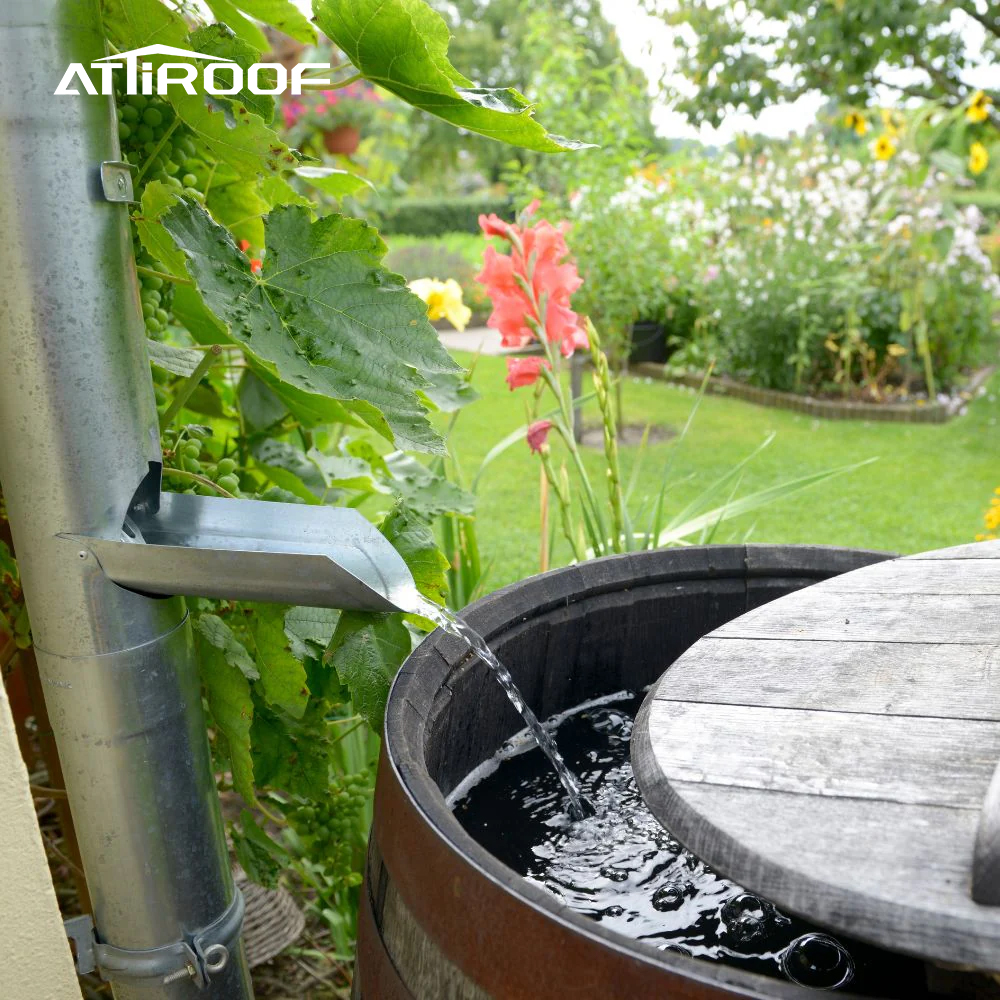
Rainwater harvesting is an ancient practice that's gaining renewed interest in modern times, especially as water conservation becomes a critical component of sustainable living. Gutter systems play a pivotal role in this eco-friendly endeavor, effectively channeling and collecting rainwater from roofs. This section explores how gutter systems are being optimized for rainwater harvesting and the environmental benefits they offer.
1. Integration with Rainwater Collection Systems:
Gutter systems can be seamlessly integrated with rain barrels, cisterns, or underground water storage tanks. These setups collect and store rainwater for non-potable uses such as gardening, lawn irrigation, and even for certain household tasks after proper treatment.
2. Water Conservation:
By collecting rainwater, gutter systems help reduce the reliance on municipal water supplies, leading to significant water conservation. According to the EPA, rainwater harvesting can save up to 1,300 gallons of water during the peak summer months.
3. Reduced Stormwater Runoff and Erosion:
Harvesting rainwater directly from gutters reduces the volume of stormwater runoff, mitigating soil erosion and preventing pollutants from entering local waterways. This is particularly beneficial in urban areas where impermeable surfaces are prevalent.
4. Enhanced Water Quality:
Rainwater is free from many of the contaminants and chemicals found in ground or municipal water sources. When used for irrigation, it provides a healthier, chemical-free option for plants and landscapes.
5. Optimized Gutter Design for Harvesting:
Gutter systems designed for rainwater harvesting typically feature larger channels and downspouts to maximize water capture. Gutter guards and filtration systems ensure that the collected water is free from debris and leaves.
6. Economic Benefits:
Apart from environmental advantages, rainwater harvesting can lead to substantial cost savings by reducing water bills. The initial investment in a rainwater collection system is often recouped over time through these savings.
7. Climate Resilience:
In areas prone to droughts or where water restrictions are common, rainwater harvesting provides a reliable, independent water source, enhancing the resilience of households to climate variability.
By incorporating gutter systems into rainwater harvesting practices, homeowners can significantly contribute to water conservation efforts and enjoy the associated environmental and economic benefits. As awareness of sustainable living practices grows, the role of gutter systems in water conservation is expected to become increasingly integral to residential and commercial property designs.
Selecting the right gutter system to complement your roof tiles is not just a matter of functional necessity; it's also an opportunity to enhance the aesthetic harmony and architectural integrity of your home. A well-matched gutter system not only efficiently manages rainwater but also seamlessly integrates with the style and material of your roof, contributing to the overall curb appeal of your property.
In this section, we delve into the nuances of matching gutter systems with different types of roof tiles, focusing on compatibility and customization options for a cohesive and functional roofing solution.
The choice of gutter system should be influenced by the type of roofing material used, as each material has unique characteristics and requirements. Here's how to ensure compatibility between your gutters and various roof materials:
1. Asphalt Shingles:
●Most gutter materials work well with asphalt shingles, the most common roofing material. Aluminum gutters, in particular, are favored for their cost-effectiveness and durability.
●Ensure that the gutter system provides adequate drainage for the potentially high water volume that asphalt shingles can shed during heavy rains.
2. Metal Roofing:
●Metal roofs are durable and have a sleek appearance. Matching them with steel or aluminum gutters can create a cohesive look. Copper gutters can also be a great match, offering a contrasting aesthetic that ages beautifully.
●It's important to consider the rate of water runoff, which can be rapid on metal surfaces. Wider gutters and downspouts may be necessary to handle the increased flow.
3. Tile Roofing (Clay or Concrete):
●Tile roofs, with their distinct Mediterranean or Spanish look, pair well with copper or steel gutters, which complement the traditional aesthetic and are capable of supporting the weight of these heavier roofing materials.
●The gutter system should be robust to manage the significant water runoff during heavy rains and the debris that tile roofs can shed.
4. Slate Roofing:
●Slate roofs are known for their elegance and longevity. Copper gutters are a popular choice for slate roofs, as they match the premium look and are equally durable.
●The gutter system should be installed with precision to prevent any damage to the edges of the slate tiles.
5. Wooden Shingles or Shakes:
●Wooden roofs have a rustic charm and require a gutter system that complements this natural aesthetic. Copper or wooden gutters can be a good match, offering a traditional look.
●Gutter guards are recommended to prevent leaves and pine needles from clogging the system, considering the typical environment around homes with wooden roofs.
When matching gutter systems to roof tiles, it's not just about the material but also about color, style, and installation nuances. The right choice will ensure functional efficiency and contribute to the visual harmony of your home's exterior.
In the next section, we'll explore customization options that allow for seamless integration of gutter systems with various types of roof tiles, ensuring a perfect match for every architectural style.

Achieving a seamless integration between your gutter system and roof tiles is not only about functional compatibility; it's also about creating a cohesive aesthetic that enhances your home's architectural design. Customization options in gutter systems allow for this seamless integration, ensuring that your gutters not only perform efficiently but also elevate the overall appearance of your home. Here are some customization options to consider for a perfect match between your gutter system and roof tiles:
1. Color Matching:
●Many gutter systems come in a wide range of colors or can be painted to match your roof tiles and trim perfectly. This creates a harmonious look and can make the gutters appear as a natural extension of your roof.
●Powder coating is a popular option for achieving durable and consistent color on metal gutters.
2. Material Selection:
●Choosing a gutter material that complements or contrasts with your roof tiles can significantly impact the aesthetic appeal of your home. For instance, copper gutters can add a touch of elegance to slate or tile roofs, while aluminum gutters can provide a sleek, modern look when paired with metal roofs.
●Consider the longevity, maintenance, and patina of materials like copper, which can add character to your home over time.
3. Style and Shape:
●The profile of the gutter (K-style, half-round, etc.) can be chosen to match the architectural style of your home. For example, half-round gutters are often used for historical or traditional-style homes, while K-style gutters suit more modern designs.
●Custom shapes and styles can also be fabricated, offering unique design solutions that perfectly align with your home's character.
4. Custom Fabrication:
●For unique roof designs, custom-fabricated gutters can ensure a perfect fit and function. This involves professional measurements and manufacturing to create a gutter system tailored to your home's specific dimensions and style.
●Seamless gutters are often custom-fabricated on-site to fit your home exactly, eliminating joints and reducing the potential for leaks.
5. Decorative Accents:
●Decorative elements such as leader heads, also known as conductor heads, and decorative downspout brackets can add a distinctive touch to your gutter system, enhancing the overall look of your home.
●These accents can be chosen to complement architectural details of your home, creating a cohesive and thoughtfully designed appearance.
6. Professional Consultation:
●Consulting with a professional can provide valuable insights into the latest trends, materials, and custom options for your gutter system. They can also help you navigate the myriad of choices to find the best solution for your home.
By leveraging these customization options, homeowners can ensure their gutter systems are not just functional but also an integral part of their home's design aesthetic. A well-integrated gutter system not only protects your home from water damage but also contributes to its curb appeal, potentially enhancing the overall value of the property.
Investing in a quality gutter system is crucial for protecting your home from water damage, but it also requires careful financial planning. The cost of gutter systems varies widely based on materials, installation complexity, and the size of your home.
Understanding the factors that influence pricing can help you make an informed decision and plan your budget effectively. In this section, we provide a comprehensive guide to the pricing of different gutter systems, offering insights to help you estimate the costs and plan your budget for both installation and ongoing maintenance.
The price of gutter systems can vary significantly depending on the material, style, and whether you opt for sectional or seamless construction. Here's a breakdown of the typical costs associated with different gutter materials:
1. Vinyl Gutters:
●Cost: $3 to $5 per linear foot.
●Characteristics: Vinyl gutters are the most affordable option. They are lightweight, easy to install, and resistant to rust and corrosion. However, they may not be as durable as other materials, especially in very cold climates.
2. Aluminum Gutters:
●Cost: $4 to $9 per linear foot.
●Characteristics: Aluminum gutters are a popular choice due to their durability, rust resistance, and wide range of color options. They offer a good balance between cost and longevity.
3. Steel Gutters:
●Cost: $8 to $10 per linear foot.
●Characteristics: Steel gutters are more durable and sturdier than aluminum. Galvanized steel gutters are especially resistant to rust but require more maintenance to prevent corrosion.
4. Copper Gutters:
●Cost: $15 to $25 per linear foot.
●Characteristics: Copper gutters are a premium option. They are highly durable, do not rust, and develop a beautiful patina over time. They are also the most expensive due to their material cost and the need for professional installation.
5. Zinc Gutters:
●Cost: $10 to $20 per linear foot.
●Characteristics: Zinc gutters are durable and long-lasting, similar to copper. They also develop a protective patina but are slightly less expensive than copper.
6. Wood Gutters:
●Cost: $12 to $20 per linear foot.
●Characteristics: Wood gutters are less common and are typically used in restoration projects for historic homes. They require regular maintenance to prevent rot and water damage.
Remember, the above costs are rough estimates and can vary based on your location, the complexity of your gutter system, and installation charges. It's also important to factor in additional costs for downspouts, gutter guards, and other accessories. In the next section, we'll provide some budgeting tips to help you plan for both the initial installation and long-term maintenance of your gutter system.
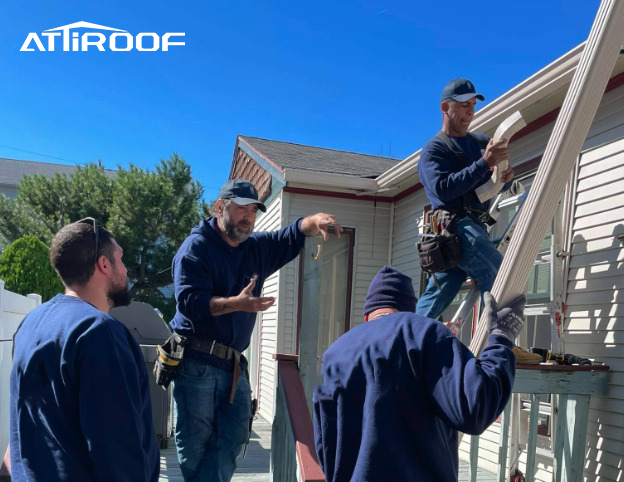
Investing in a gutter system is a significant financial decision that requires thoughtful planning and budgeting. Beyond the initial installation costs, considering long-term maintenance expenses is crucial for making an informed investment. Here are some valuable budgeting tips to help you navigate the financial aspects of gutter installation and maintenance:
1. Consult with Attiroof Experts:
Reach out to our Attiroof specialists for a comprehensive quote. Our team not only provides competitive pricing but also ensures that you receive top-quality materials and service. By consulting directly with us, you'll benefit from our expertise in roofing solutions, ensuring that your investment brings long-term value and protection to your home.
2. Consider Long-Term Value:
While it might be tempting to choose the least expensive option, consider the durability and expected lifespan of the materials. Sometimes, investing a bit more upfront can save you money in the long run on repairs and replacements.
3. Factor in All Costs:
Remember to include all related costs in your budget, not just the gutters themselves. This includes downspouts, gutter guards, installation fees, and any potential repairs to your fascia or roofing that might be necessary during installation.
4. Plan for Maintenance:
Regular maintenance can greatly extend the life of your gutter system. Set aside a portion of your budget for routine cleaning, inspections, and minor repairs. This can prevent more costly issues down the line.
5. Save for Unexpected Repairs:
It's wise to have a contingency fund for unexpected repairs or issues that may arise, especially after severe weather conditions.
6. Invest in Quality Installers:
The quality of installation can significantly impact the longevity and effectiveness of your gutter system. Investing in experienced, reputable installers can lead to fewer problems and lower maintenance costs in the future.
7. Consider Gutter Guards:
While adding to the initial cost, gutter guards can reduce the frequency and cost of cleaning and maintenance. They can be a wise investment, particularly if your home is surrounded by trees.
8. Understand Warranties and Service Plans:
Know the details of any warranties offered by the gutter material manufacturer and the installation company. Some companies also offer service plans for regular maintenance, which can be a cost-effective way to ensure your gutters are well-maintained.
By taking these factors into account, you can create a comprehensive budget that covers not only the initial installation but also the ongoing maintenance of your gutter system. Careful planning and investing in quality materials and installation can minimize future costs and ensure your gutter system provides effective protection for your home for years to come.
The real-world impact of gutter systems extends far beyond mere aesthetics; they are fundamental to preserving the structural integrity of homes, preventing water damage, and contributing to the overall well-being of the occupants. In this section, we present a series of case studies that highlight the transformative role of effective gutter systems in enhancing the functionality and livability of real homes.
1. Overcoming Water Damage in a Coastal Home
●Background: Situated in a coastal region prone to heavy rainfall, a residential property was frequently experiencing water seepage in the basement and soil erosion around the foundation.
●Solution: The installation of a high-capacity, seamless gutter system with integrated gutter guards significantly reduced the overflow during heavy rains. The improved water management system effectively channeled water away from the foundation, mitigating the risks of basement flooding and soil erosion, thereby protecting the home's structural integrity.
2. Enhancing Roof Longevity in a Snow-Prone Area
●Background: A home in a region with harsh winters was encountering issues with ice dams and excessive snow accumulation on the roof, leading to potential roof damage and leaks.
●Solution: The strategic placement of heated gutter cables and the installation of sturdy, weather-resistant gutters mitigated the formation of ice dams. This proactive approach not only prevented damage to the roof and gutters but also ensured a safer environment by reducing the risk of falling icicles.
3. A Rainwater Harvesting Solution for a Sustainable Household
●Background: An environmentally-conscious homeowner wanted to reduce their dependence on municipal water and sought a sustainable solution for their garden irrigation needs.
●Solution: By integrating their gutter system with a rainwater harvesting setup, the homeowner was able to collect and store rainwater efficiently. This sustainable approach not only provided a reliable water source for their garden during dry spells but also contributed to a reduction in their water bills and ecological footprint.
These case studies exemplify the functional advantages and real-life benefits of having an effective gutter system in place. From safeguarding the structural integrity of homes against water damage to promoting sustainable living practices, the importance of a well-designed gutter system in enhancing the quality and functionality of residential properties is undeniable.
Hearing directly from homeowners provides invaluable insights into the real-life benefits and enhancements brought by effective gutter systems. These testimonials and feedback highlight not only the functional improvements but also the peace of mind and satisfaction experienced by homeowners who have invested in quality gutter solutions. Below are some authentic testimonials and feedback from homeowners who have seen significant improvements in their homes after installing or upgrading their gutter systems.
1. Testimonial from a Homeowner in a Rain-Heavy Region:
"Before we upgraded our gutter system, every heavy rainstorm was a cause for concern. We frequently dealt with basement flooding and the constant worry of water damage. After consulting with experts and installing a more robust, clog-free gutter system, the difference has been night and day. Our basement stays dry, and the peace of mind knowing our home is protected is invaluable. It was an investment that paid off manifold."
2. Feedback from a Homeowner with Newly Installed Rainwater Harvesting:
"Integrating a rainwater harvesting system with our new gutters was one of the best decisions we made during our home renovation. Not only are we contributing to water conservation, but we also have a sustainable source for watering our garden. It's fulfilling to see how a simple upgrade can have such a positive impact on our lifestyle and the environment."
3. Testimonial from a Homeowner in a Cold Climate:
"Dealing with ice dams and icicles was a regular winter nuisance that we dreaded. The damage it caused over the years was not just dangerous but also costly. After installing heated gutter cables and a more durable gutter system, our winters have been worry-free. The system effectively prevents ice buildup, protecting our roof and making our home safer. This upgrade was definitely worth it for the durability and safety it brought to our home."
These testimonials underscore the transformative effect that a well-thought-out gutter system can have on a property. From enhancing the home's resilience against harsh weather conditions to contributing to sustainability and providing homeowners with peace of mind, the right gutter system is a crucial component of any well-maintained home. These real-life stories reaffirm the value of investing in a quality gutter solution, not just as a functional necessity but as an integral part of a comfortable, secure, and eco-friendly living environment.
The journey through the diverse world of gutter systems culminates in a clear understanding that a robust, well-integrated gutter system is not merely an accessory but a fundamental component of your home's longevity and protection. Attiroof's commitment to excellence is reflected in every piece of advice, suggestion, and insight shared in this comprehensive guide.
1. Importance of Quality Gutter Systems:
A well-functioning gutter system is essential for protecting your home's structure from water damage, preserving the integrity of the foundation, and preventing issues like soil erosion and basement flooding.
2. Material Matters:
The choice of material for your gutter system (be it aluminum, vinyl, copper, steel, or zinc) significantly impacts its durability, maintenance requirements, and aesthetic appeal. Each material has its unique benefits and considerations.
3. Design and Integration:
The design of the gutter system should not only be functional but also harmonize with your home's architectural style. Seamless integration, color matching, and style selection are crucial for enhancing curb appeal.
4. Maintenance is Key:
Regular maintenance, including cleaning and inspections, is vital to ensure the optimal performance of your gutter system. Preventative measures can avert costly repairs and extend the life of your gutters.
5. Sustainability and Innovation:
Advancements in gutter technology, such as eco-friendly materials, smart gutter systems, and innovations like rainwater harvesting, are contributing to more sustainable living practices.
6. Professional Guidance:
While DIY options are available, consulting with professionals can provide valuable insights, especially for complex installations or when integrating advanced features like smart sensors or heating cables.
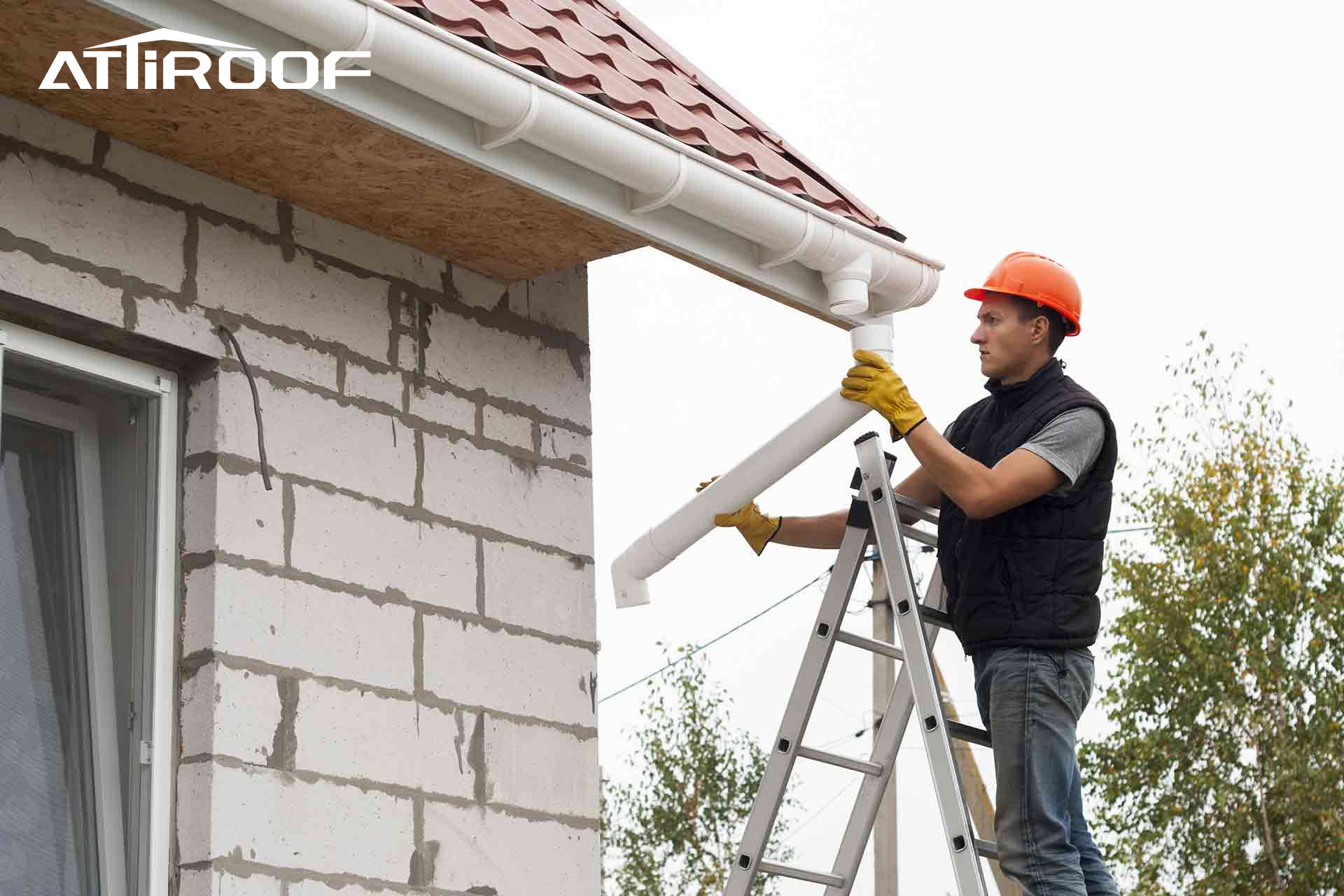
For Homeowners:
●Assess Your Needs: Consider the climate, the style of your home, and your budget. Determine what you value most in a gutter system – durability, aesthetics, eco-friendliness, or all of the above.
●Seek Professional Consultation: Especially for complex roof structures or if you're considering advanced gutter solutions, professional guidance can be invaluable.
●Plan for Maintenance: Set a schedule for regular cleaning and inspections. Consider investing in gutter guards or a maintenance plan to ensure the longevity of your gutter system.
For Professionals:
●Stay Informed: Keep up-to-date with the latest materials, technologies, and installation techniques to offer the best solutions to your clients.
●Educate Your Clients: Help clients understand the value of a good gutter system and the importance of regular maintenance.
●Offer Tailored Solutions: Provide personalized solutions based on the client's specific needs, architectural style of the home, and environmental considerations.
In Conclusion
In the end, a well-chosen, properly installed, and meticulously maintained gutter system from Attiroof is more than just an addition to your home—it's a testament to your foresight in protecting your investment and ensuring peace of mind. As you stand at the crossroads of decision-making, remember that Attiroof is here to guide you towards the pinnacle of gutter system solutions. Ready to take the next step? Contact Attiroof today and transform the way you think about gutter systems forever.
The choice of material for your gutter system depends on your specific needs, including climate, budget, and aesthetic preference. Aluminum gutters are versatile and cost-effective, while copper and steel offer higher durability and a distinct look. Vinyl is an affordable option, particularly suitable for milder climates. Consulting with Attiroof can help you choose the best material suited to your home's requirements.
It's recommended to clean and inspect your gutter system at least twice a year, usually in the spring and fall. However, if you have overhanging trees or experience heavy rainfall, you might need to clean them more frequently. Consider installing gutter guards to reduce maintenance needs.
Yes, Attiroof offers eco-friendly gutter options, including systems made from recycled materials. Additionally, integrating your gutter system with a rainwater harvesting setup can make your home more sustainable, reducing reliance on municipal water and lowering your ecological footprint.
While some homeowners opt for DIY gutter installation, it's often advisable to hire a professional, especially for complex roof layouts or when working with high-end materials like copper or steel. Professional installation ensures that your gutter system is properly fitted, secured, and sealed, reducing the risk of future issues and maximizing the system's longevity.
Previous post:None
Next chapter: Mastering Asphalt Shingles: A Complete Guide for Roofing Solutions
Hot Products
Get in Touch With Attiroof
For top-tier, custom roofing solutions, trust Attiroof. Our commitment to quality and service is unmatched. Reach out to start your project today.